My Ramblings on Compost, Mulching and Mulch
- SQWIB
- Reactions:
- Posts: 185
- Joined: Mon Dec 23, 2019 6:41 am
- Location: Zone 7A Philly
- Contact:
My Ramblings on Compost, Mulching and Mulch
Composting and mulching
October 19th, 2018
rev. 12/9/19
Composting, Mulching and Mulch
My ramblings (opinion) on compost, Mulching and Mulch.
Composting
Bin Composting
I use a few methods of composting, one of my methods is a compost bin, the dimensions of my compost bin are 28"L x 28"W x 32" and modified to 42" height.
Almost everything I have read on the internet (you know, the place that is always correct) says that you need at least 27 cubic feet or 9 cubic yards, 36" x 36" x 36" for a hot compost. I agree the bigger the better but this is just regurgitated info that some folks keep spewing out and it's nonsense.
I have no problem getting a hot compost when I try, however, I won't discuss hot compost because frankly I don't have the time or ambition of making a hot compost, I have enough stuff in the garden to worry about and don't need another thing to worry about.
I cold compost and on occasion, when I inadvertently get the mix right, it becomes a hot compost.
I don't turn, aerate or moisten, I just keep piling it up and dig out the compost from the bottom...that's it!
Now lets discuss Kitchen waste. What is kitchen waste? If you ask me, kitchen waste is uneaten food bits that get tossed in the trash and make it's way to a landfill, hence the word waste. I have very minimal kitchen waste, I do however have plenty of Kitchen scraps. What are Kitchen scraps? I consider kitchen scraps a recycled material not waste, because it is not waste, it is a renewable resource.
What do I compost? Everything that was once alive! Yes, this includes meats on occasion, milks yogurt, cheese. I won't go into everything I have composted but from the previous items mentioned you can see I compost almost everything.
Bones, Meats and dog poo will be tossed in a firepit whenever I'm having a fire, this will be for a bio-char.
Thanksgiving turkey and some outdated chicken breasts. This was in situ composted.
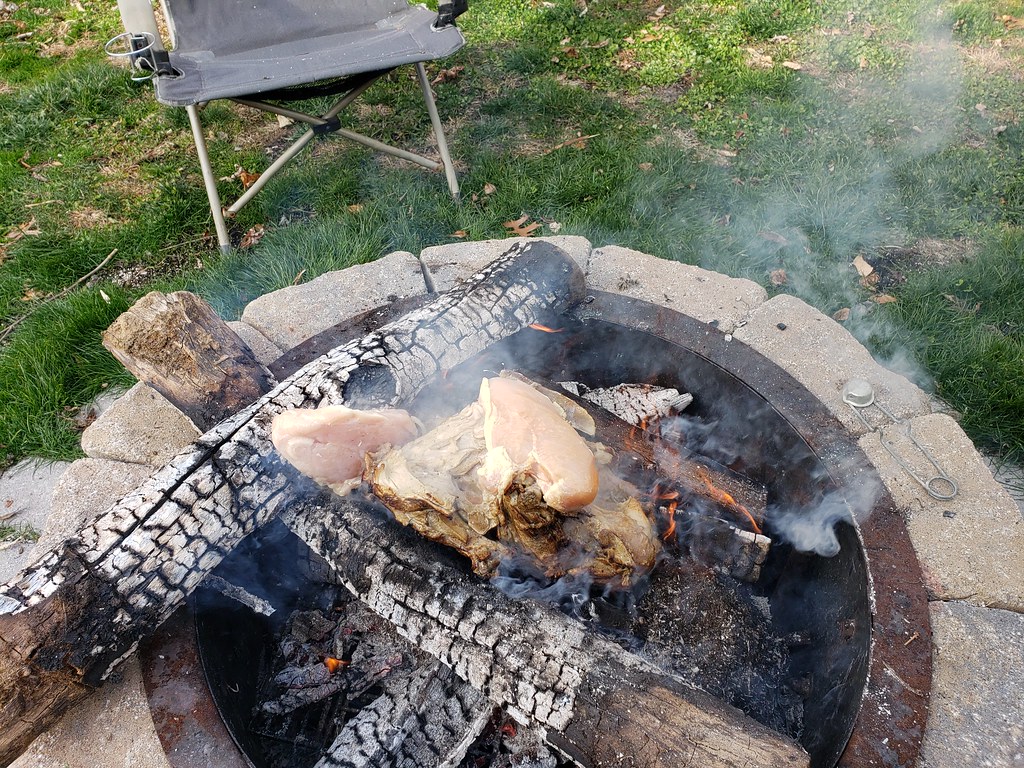
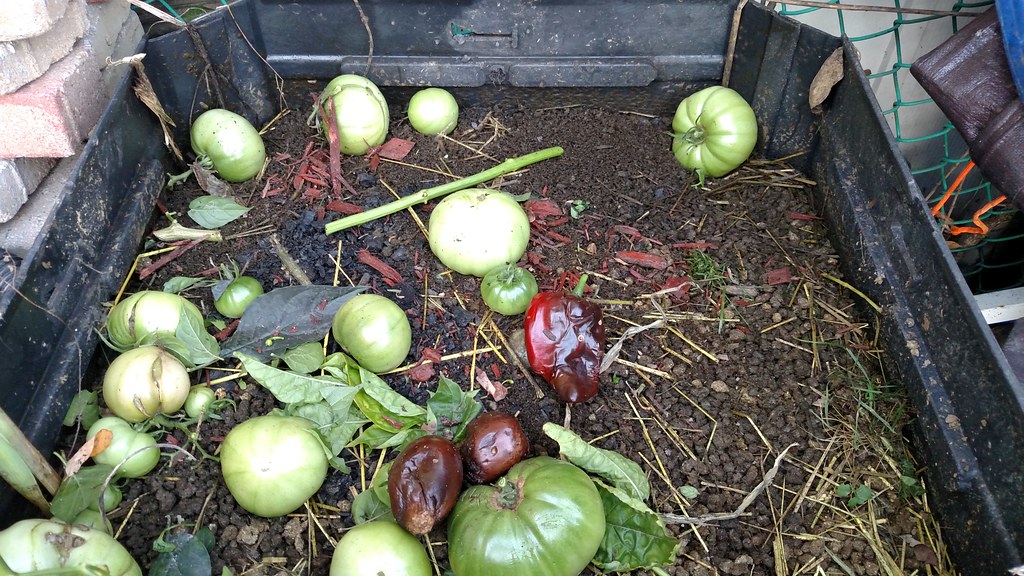
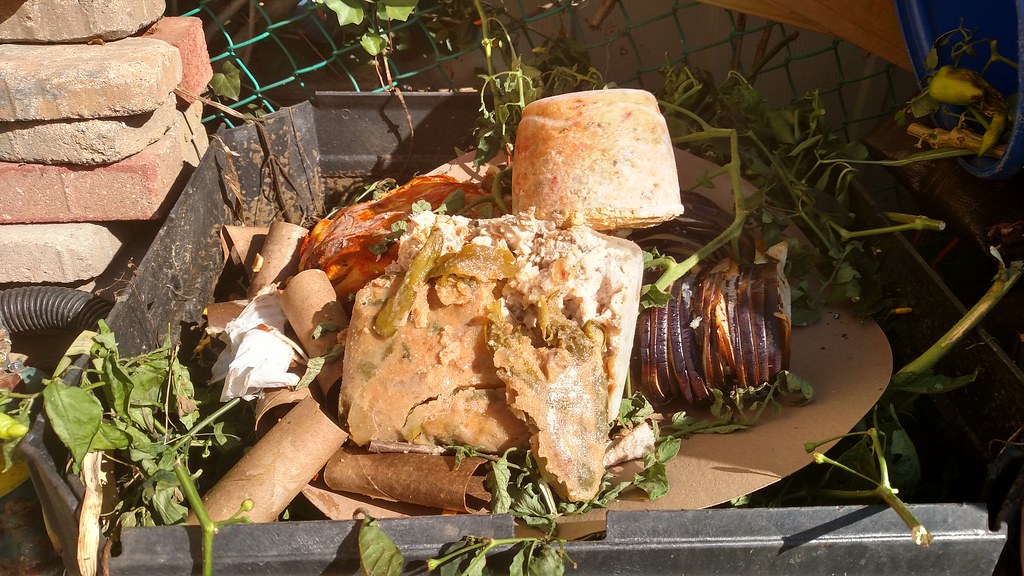

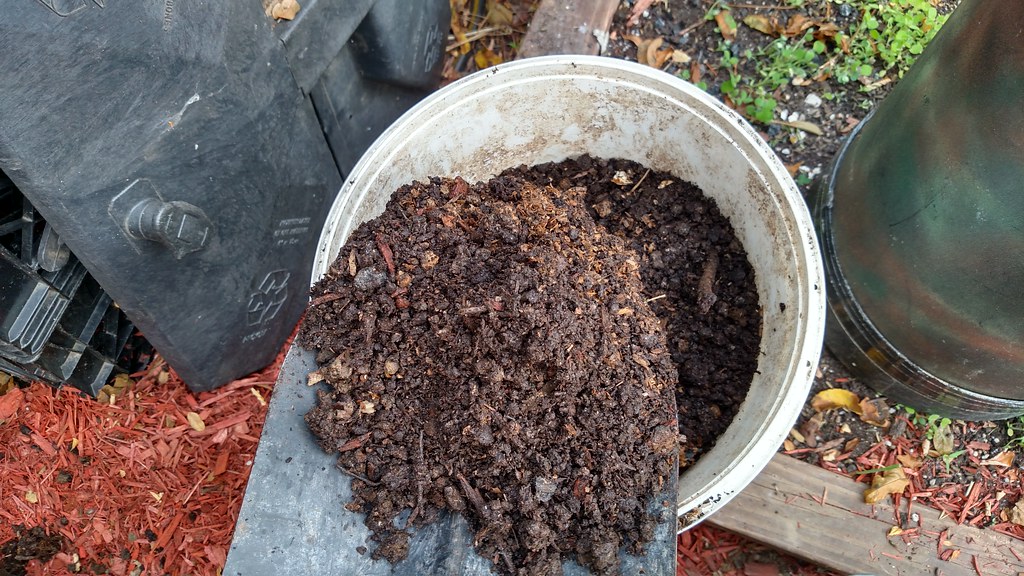
In situ composting
I religiously compost and have been composting in a compost bin for some years now, after some serious thought I decided I wanted something even easier than my current lazy composting regiment. I compost a lot more items than the average person, however this part of the article is about my method of composting not what I compost.
I decided in addition to bin composting I would try "in situ" composting, the last few years, I have been doing a lot of "composting in place" and so far it has worked out pretty well, so well in fact that I have been "in situ" composting most of my kitchen scraps and use the compost bin primarily for bulk materials like yard trimmings, cardboard, etc... or during months the ground is too frozen to dig.
I don't consider this method "trench composting", because frankly I'm not digging a trench. I have heard it cleverly referred to as "Cathole Composting", "Dig and Drop Composting" and "Direct Composting".
I practice no till, and "in-situ" composting is the only time the soil is disturbed other than planting.
I simply dig in my kitchen scraps between the plants during the growing season, mark the area, then move onto the next area. Sometime I gently moved the mulch aside, toss down the kitchen scraps directly on top of the soil (depending on the type of scraps) then slide the mulch back.
When my Hugelkultur beds were really starting to settle, some pockets/voids opened up and I would tuck my scraps and trimmings into these voids.
Even when the beds are planted heavily with cover crops in the fall, I still "in situ" compost the kitchen scraps.
Now here is where it can get a bit fuzzy between composting and mulching.
Stuff like fresh yard trimmings and subpar veggies get tossed back on top of the bed during the growing season and are left to rot then dry out to become a mulch.
These tomato cores and peels for example will be spread out and left to dry as a mulch.
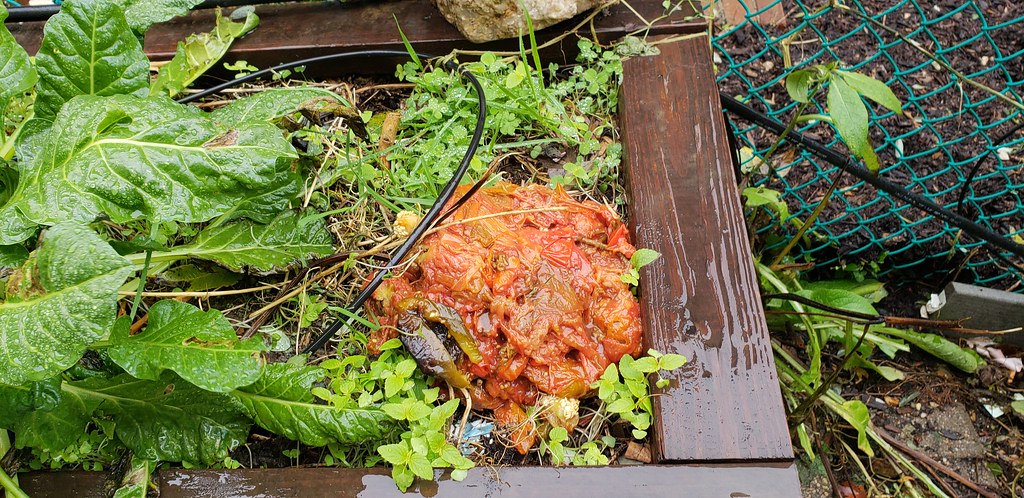
In the winter if there's snow on the beds, I just dig kitchen scraps in the snow and cover with snow. If the beds are frozen solid, I try to hold out long enough till the ground is somewhat thawed.
Stuff like Bio-char, Rabbit manure, animal bedding, vacuum cleaner remnants, hair and coffee grounds and ashes will get tossed right on top of the beds.
I would consider this practice, mulching. So to me, if scraps are under the mulch layer and in direct contact (slightly soil covered) or under the soil, I consider it composting material, if the scraps are above the soil line, I consider it a mulch (layering). There, that was easy, wasn't it?
Here are a few examples of "in-situ" composting
I pushed aside some mulch, dug out three compost holes around my apple trees, filled with kitchen scraps, covered with soil, slid the mulch back then topped with coffee grounds and some trimmed shrubs.
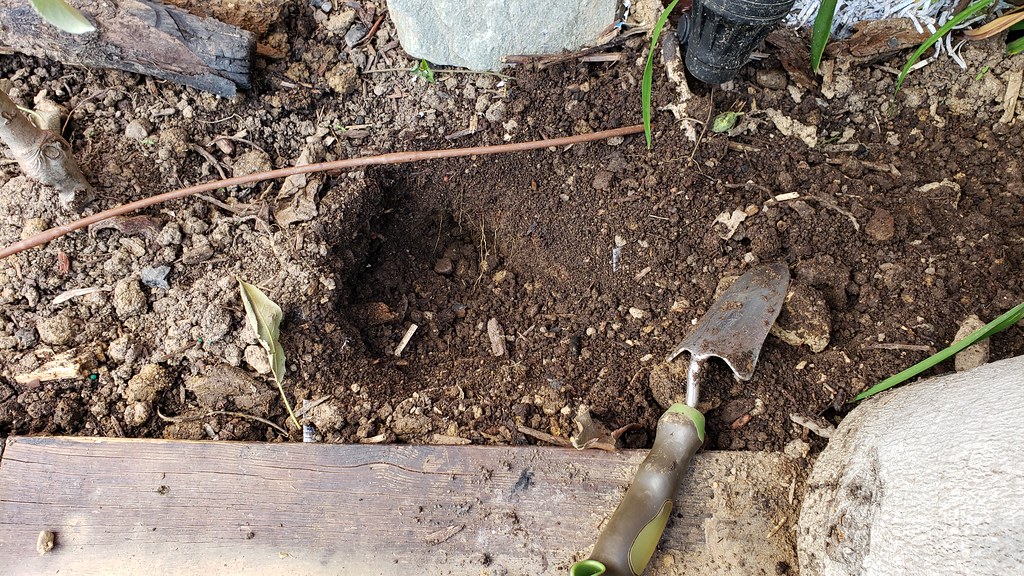
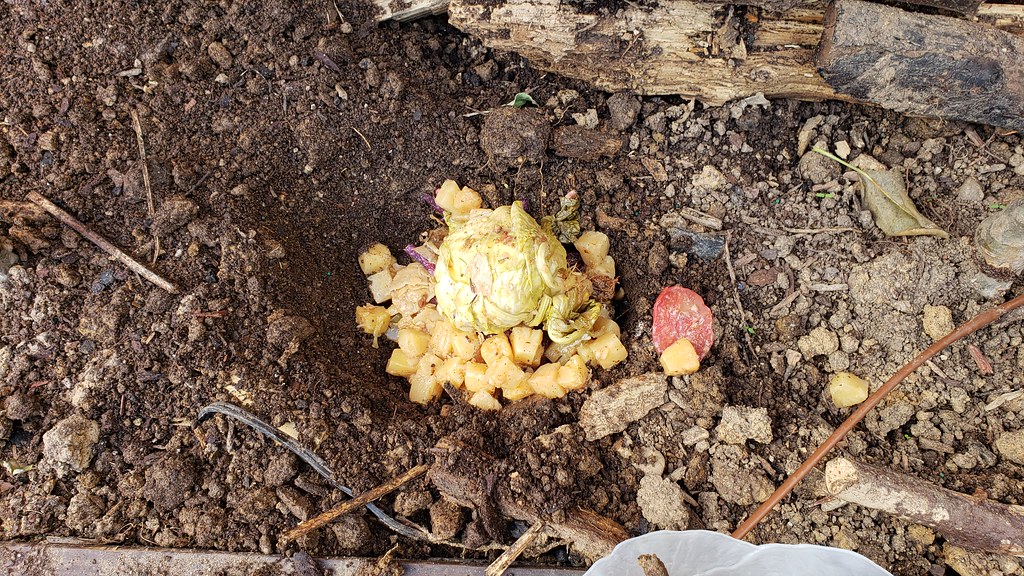
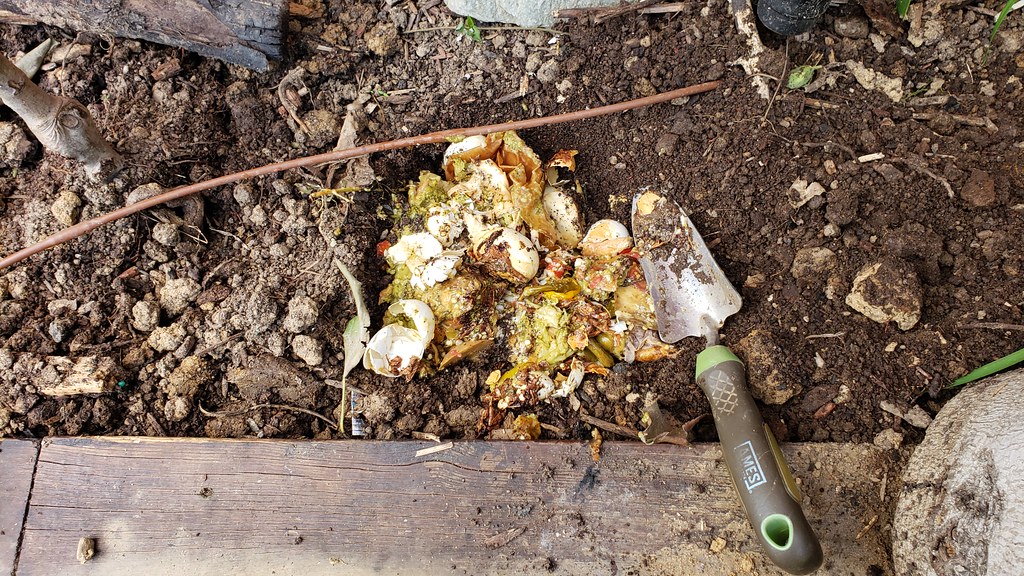
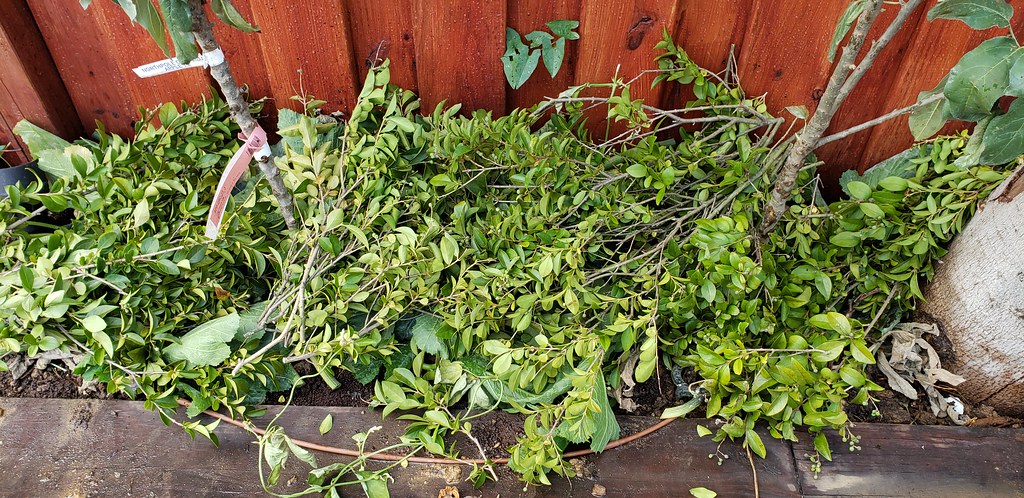
In situ composting when growing cover crops in my Hugelkultur beds.
Cover crop is pushed aside or dug up and set aside then a hole is dug.
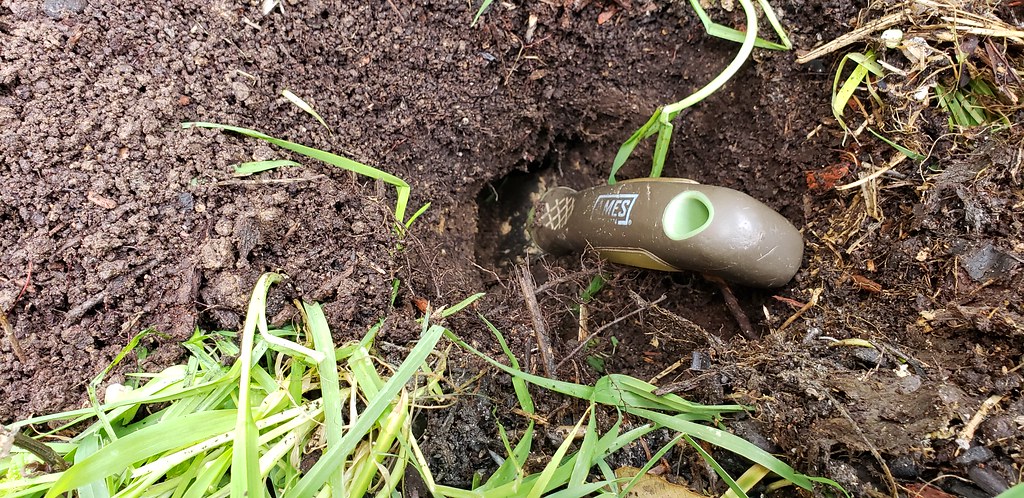
You cant see it but this is an 8" hole and there is a cavity (center of pic dark spot)that goes down a bit further maybe another 8", these beds aren't too old so there are still voids in between the wood, I try to open up these voids and pack the kitchen scraps down as far as I can.
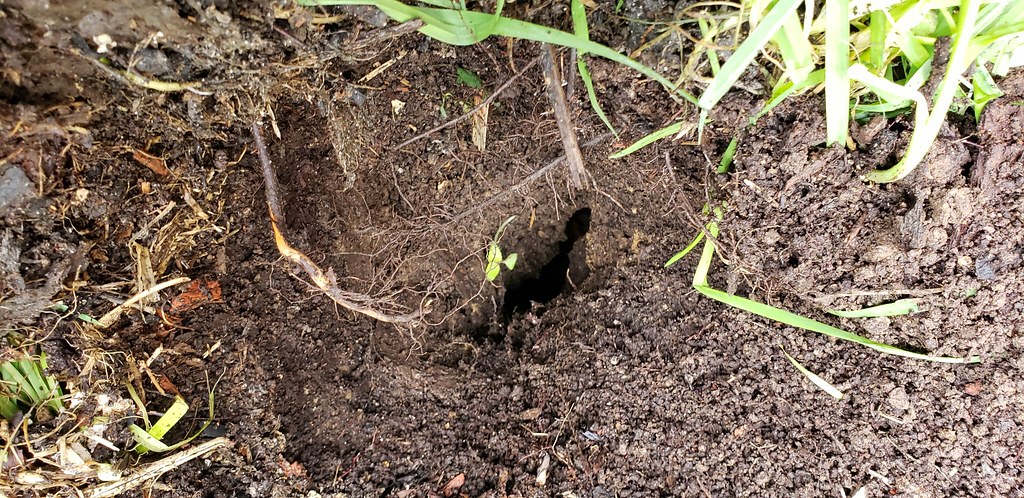
Scraps are tossed in the hole.
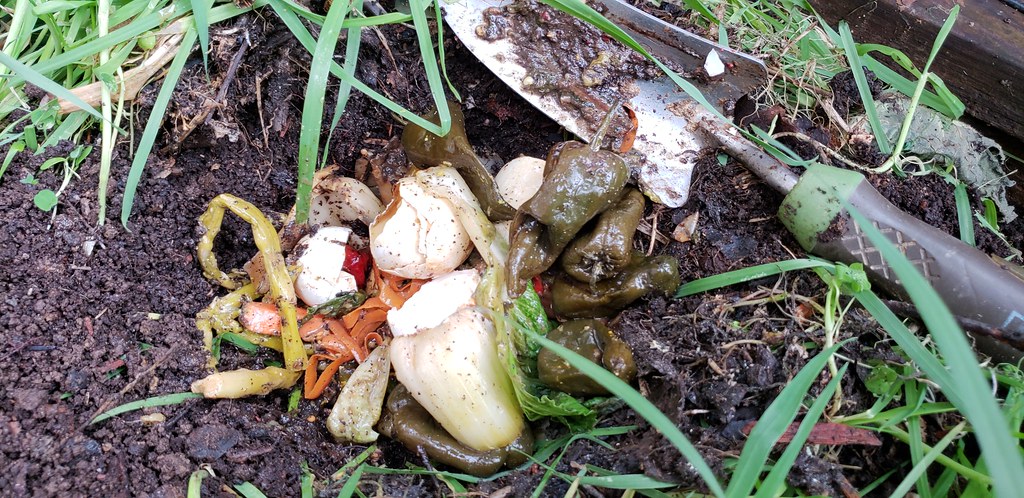
Scraps are then chopped down into the hole.
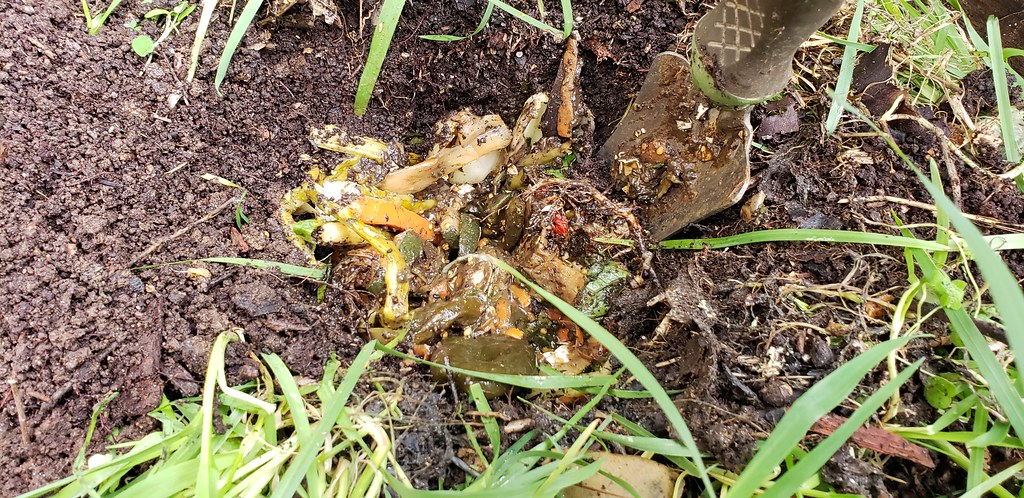
Cover crop is placed back on top or slid back in place.
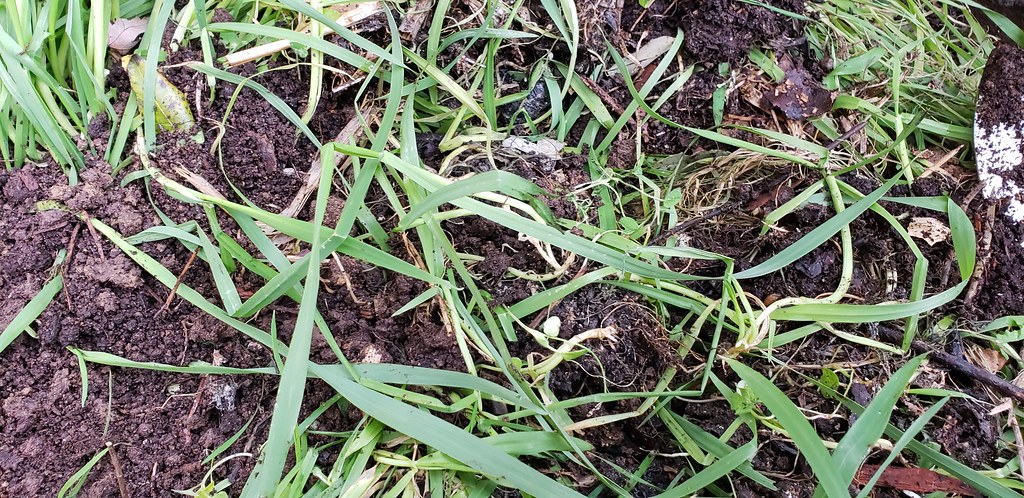
Area is watered, I usually dump about 2 gallons of rainwater over top if its early fall.
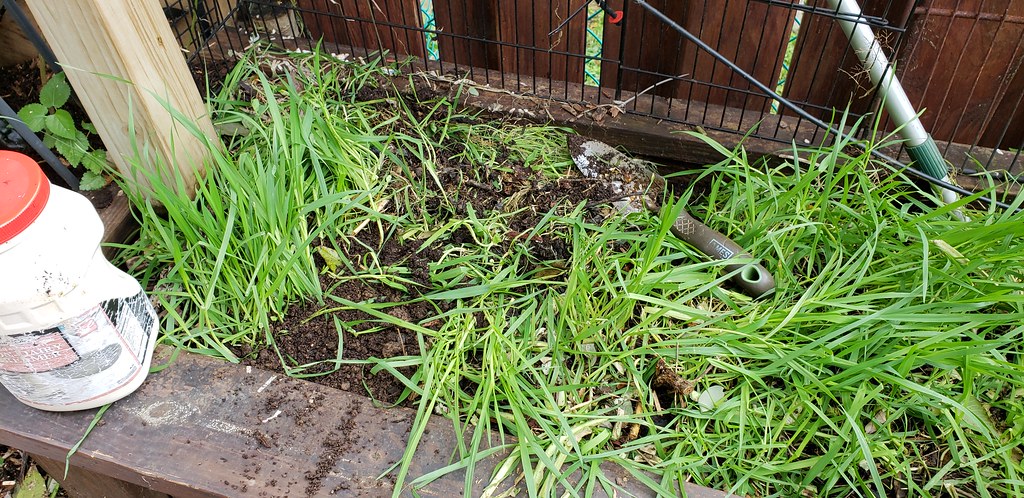
Then a flag is put in place to mark the last area that was done.
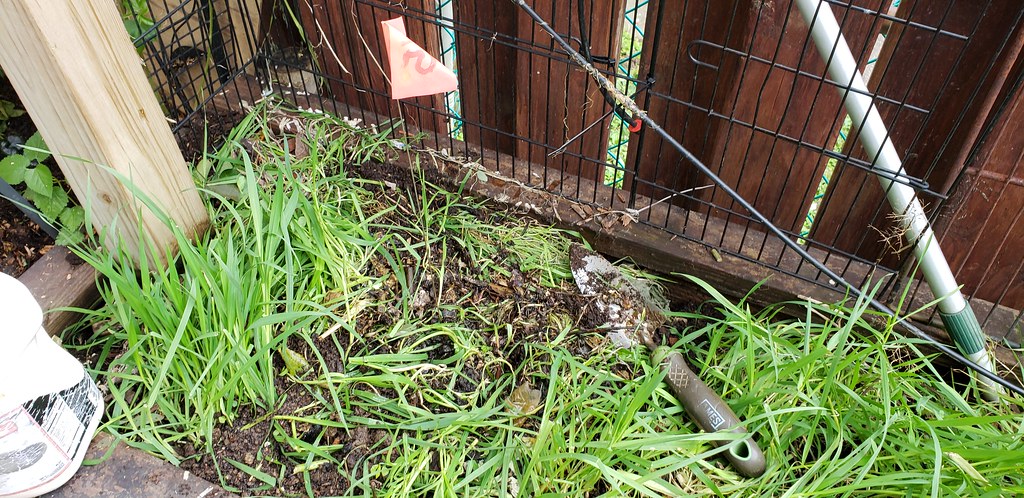
Then I move down the line about 18", same procedure as above.
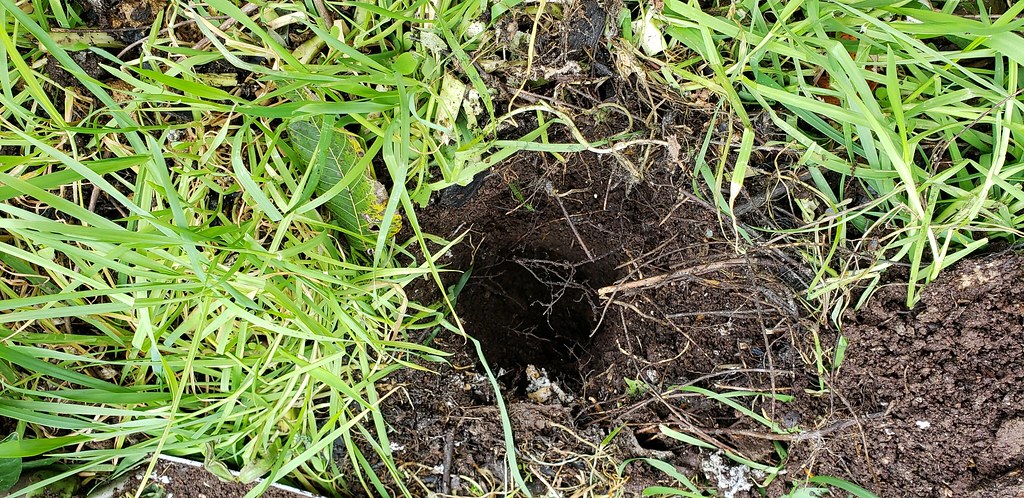
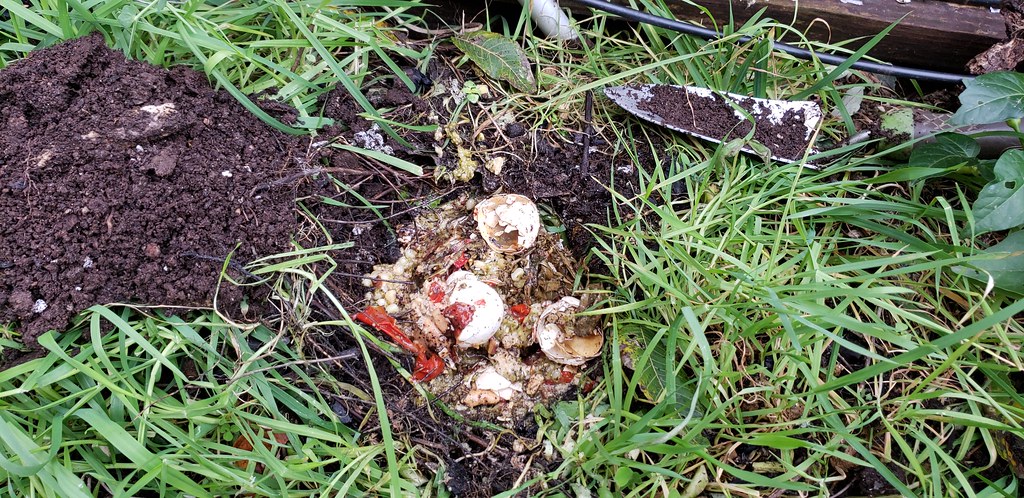
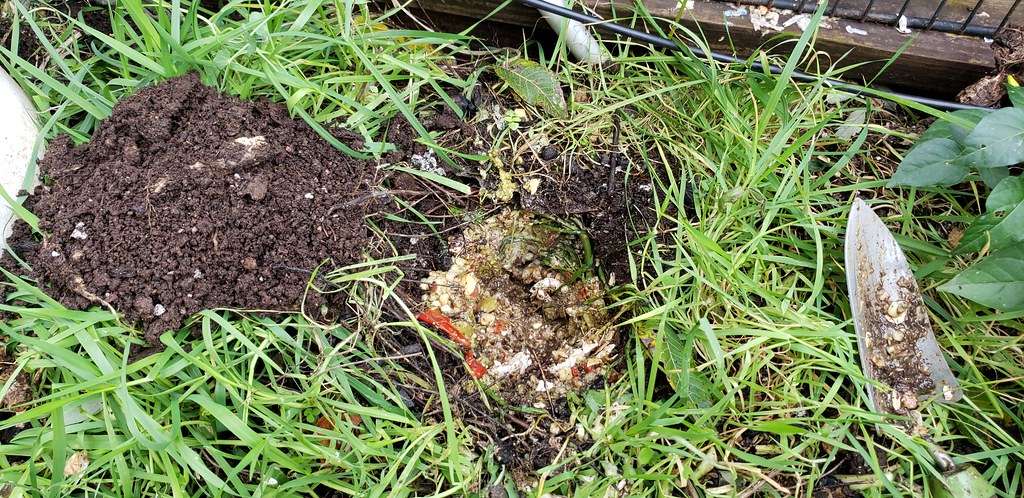
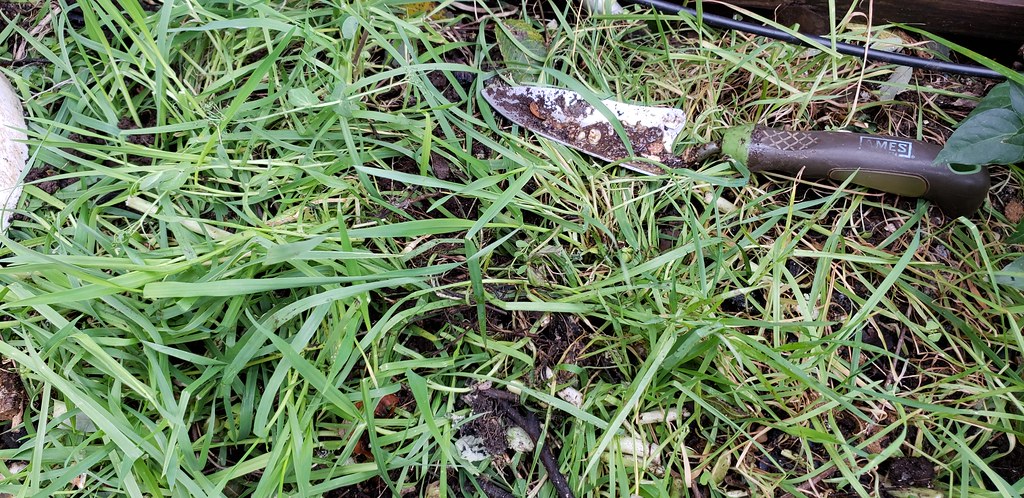
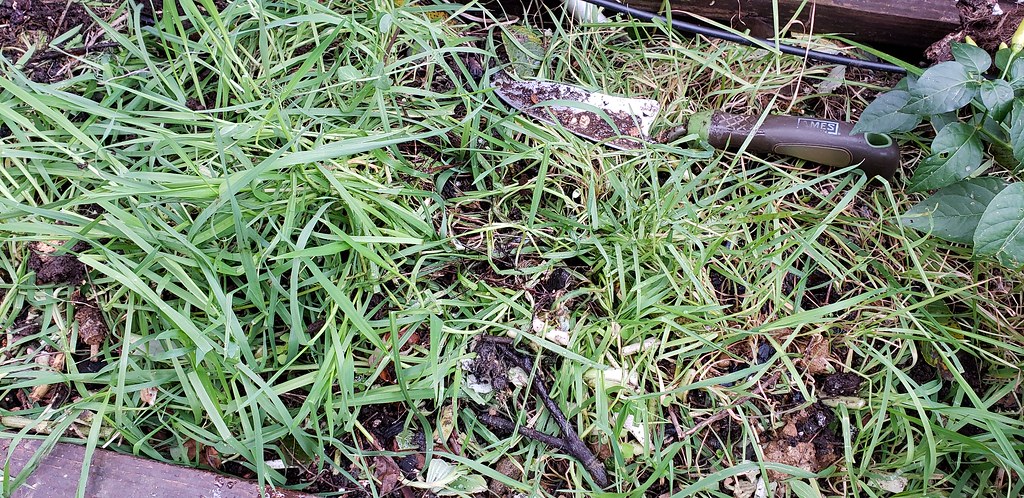
Flagged to mark the last spot.
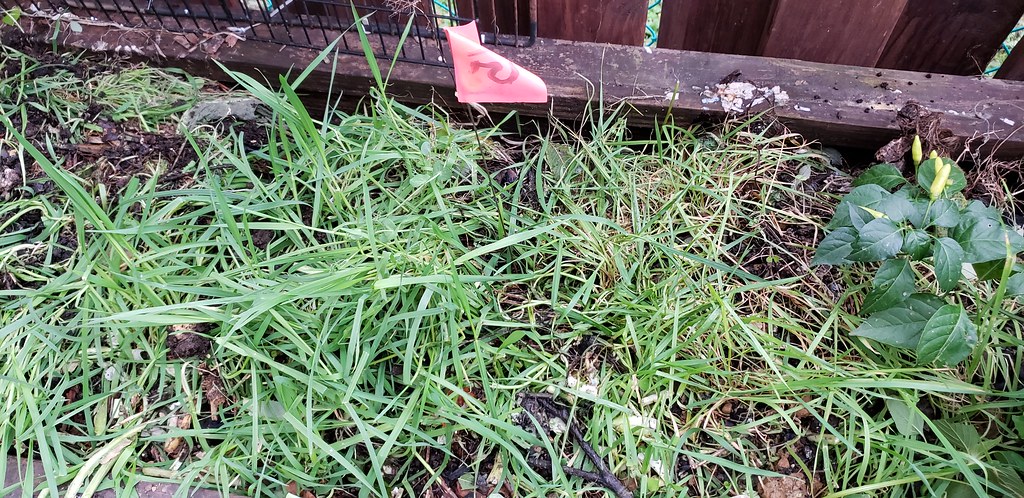
In situ composting in the winter
If the ground has been frozen I'll wait for a few warm days for the beds to thaw and try to get the compost in before the beds freeze again.
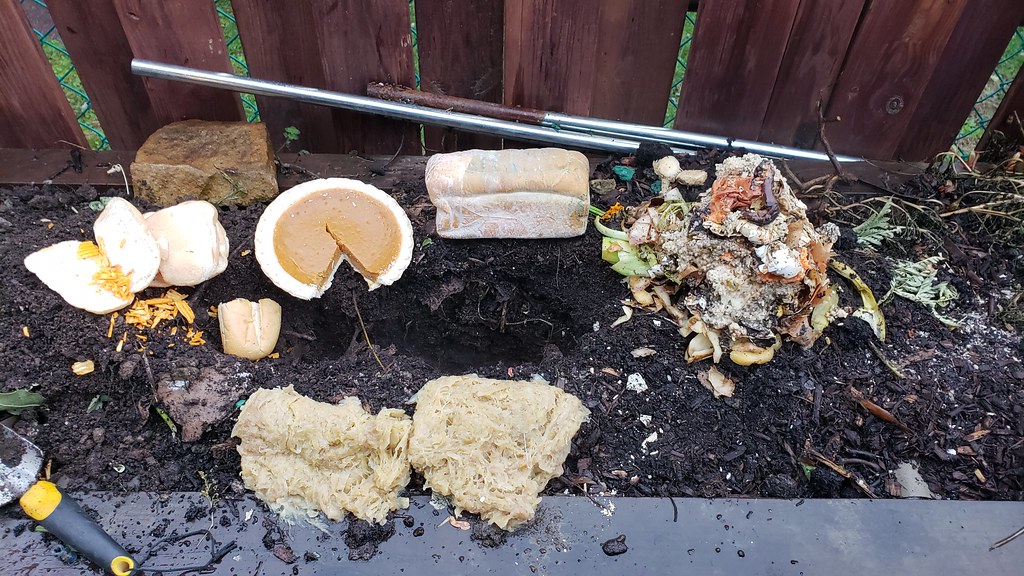
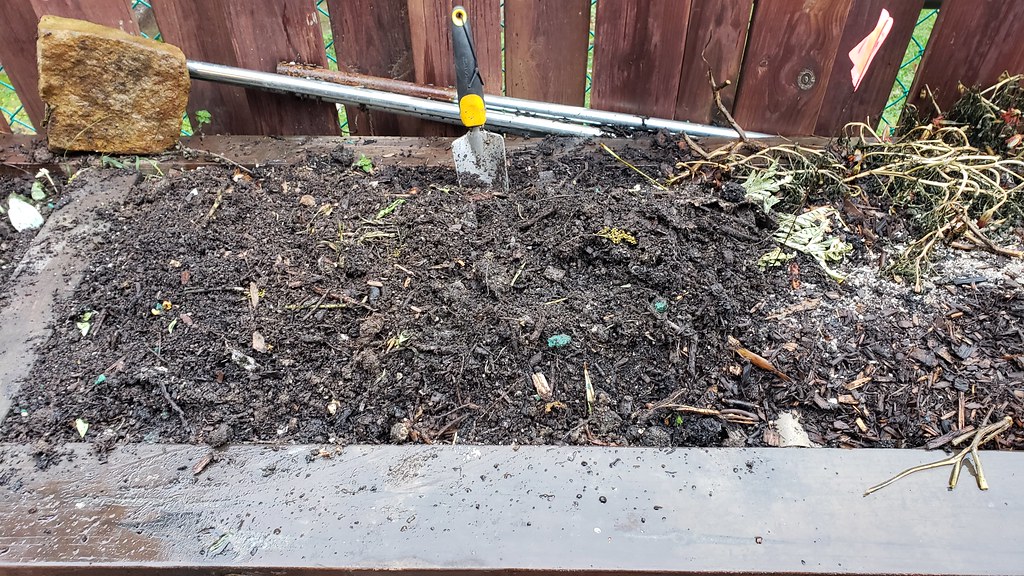
Is it better than bin composting? It doesn't matter! What matters is, there is no wrong way to compost for the obvious reasons that you are feeding your soil, using a renewable resource and keeping it out of a landfill, furthermore, this is a great way to compost if a person doesn't have the room for composting.
Disclaimer. All the above under "Composting" is based on my personal experience and no testing in labs have been done. Please note that your results may vary and there are possibilities of problems with wildlife depending on your area, so far my problem has been limited to my dogs and a visit here and there from field mice. I have had less of a problem with wildlife using this method compared to my compost bin.
Mulching and Mulch.
What do I use for mulch? Everything!
(I'll add more pics when they become available)
Water lettuce from the pond
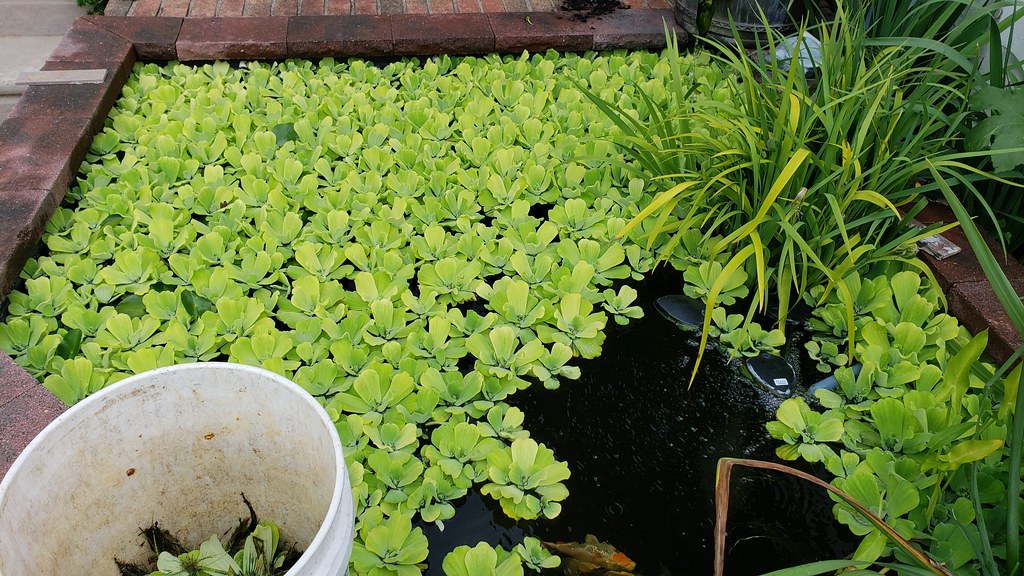
Hedge trimmings

Shredded cardboard
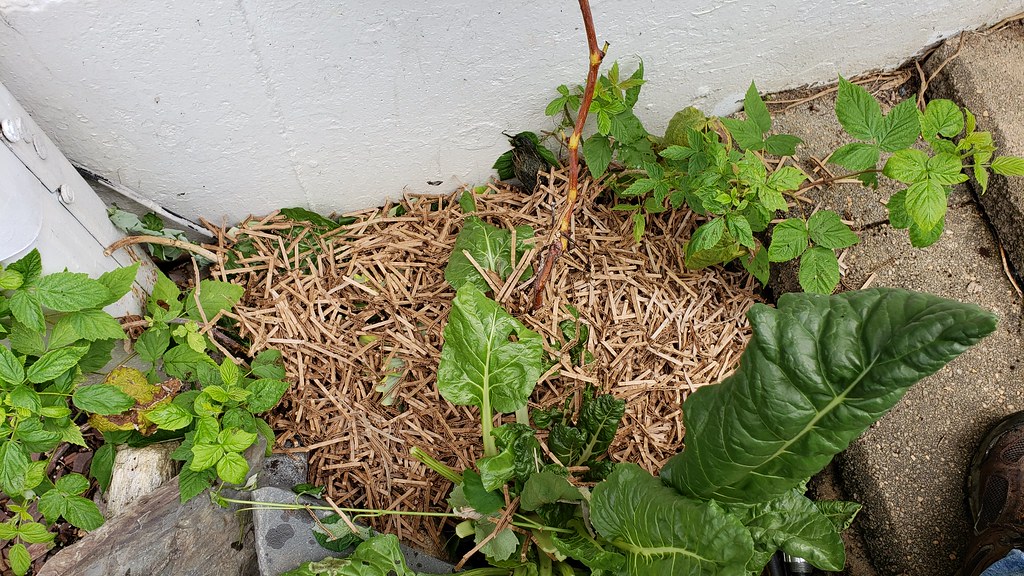
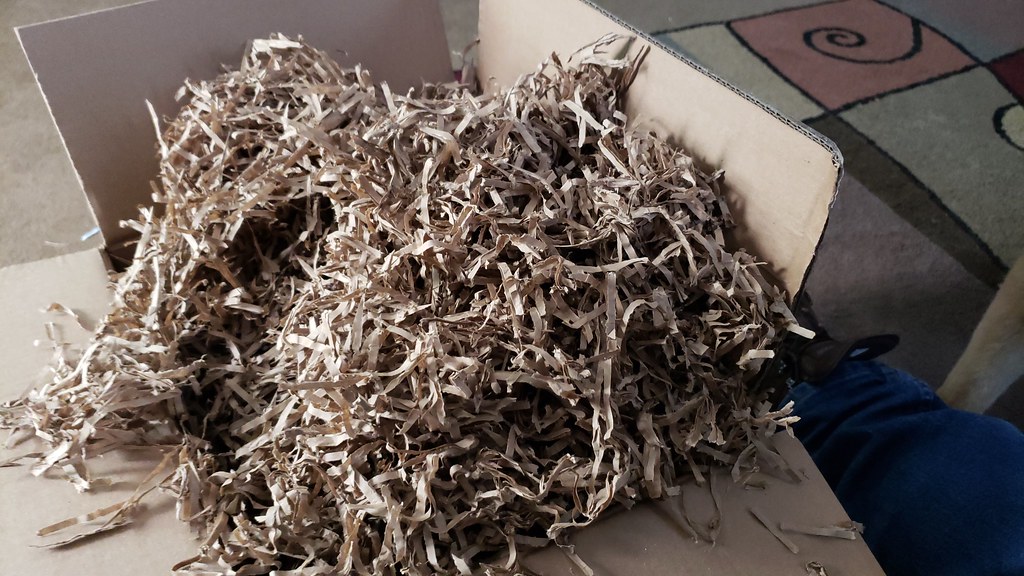
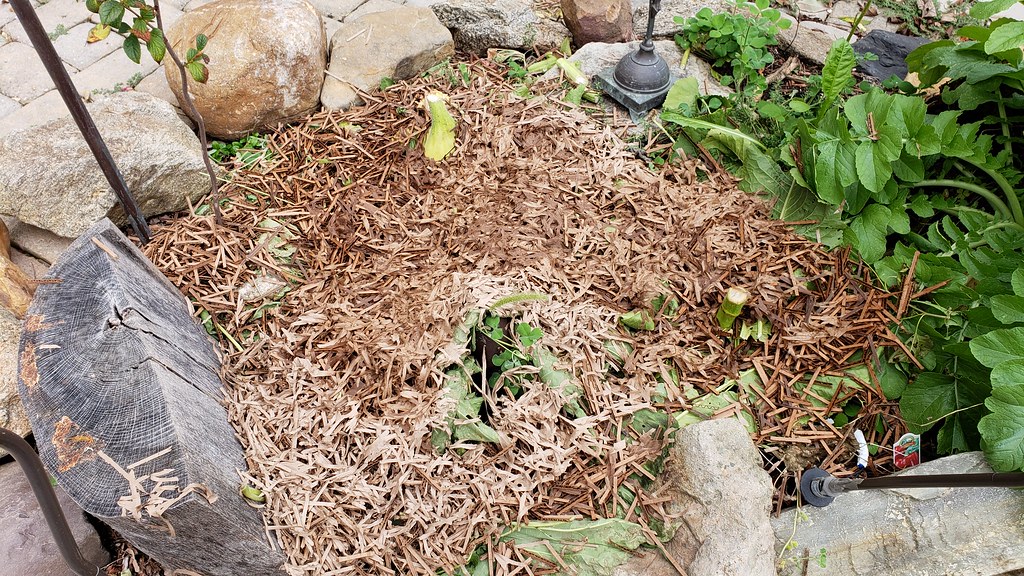

Shredded paper and cardboard.
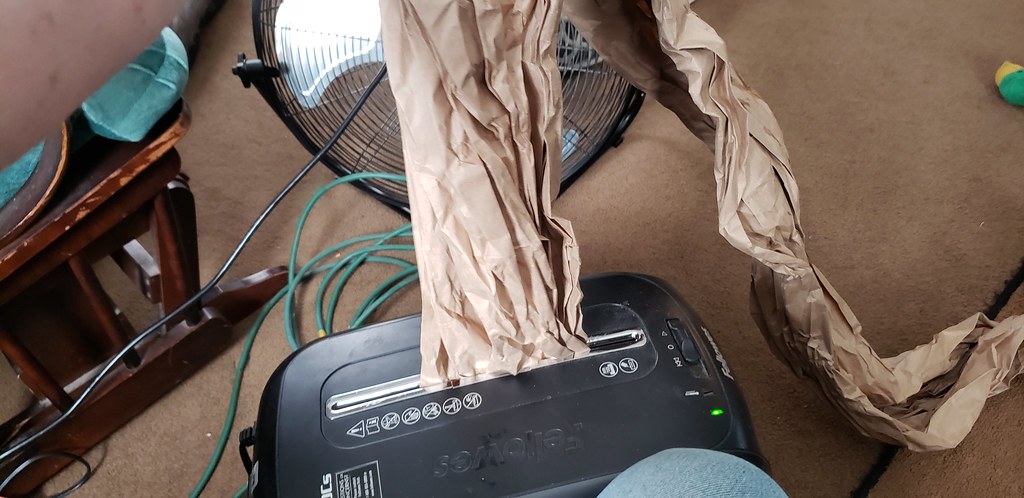


I don't use shredded paper as a mulch anymore but will bury it or use it with the "in-situ" composting, the shredded paper turns into an impermeable layer.
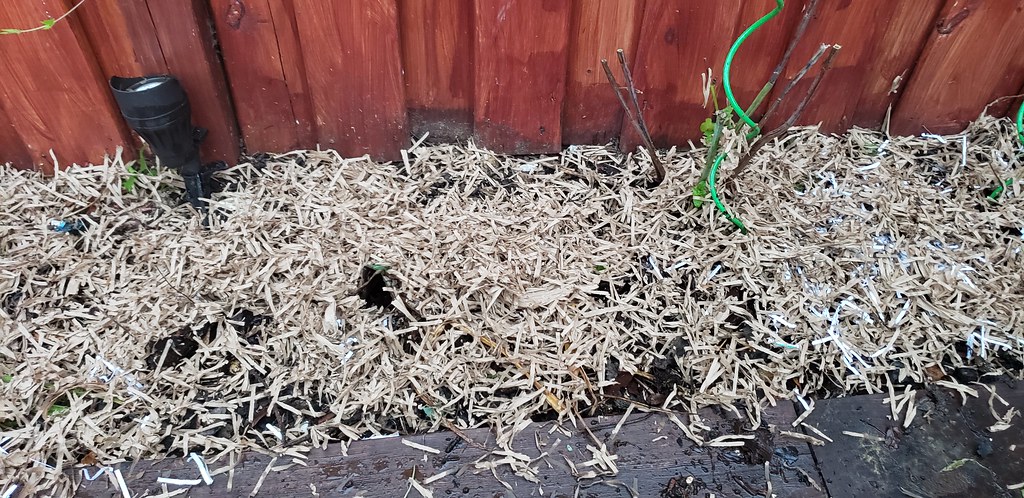
Plants
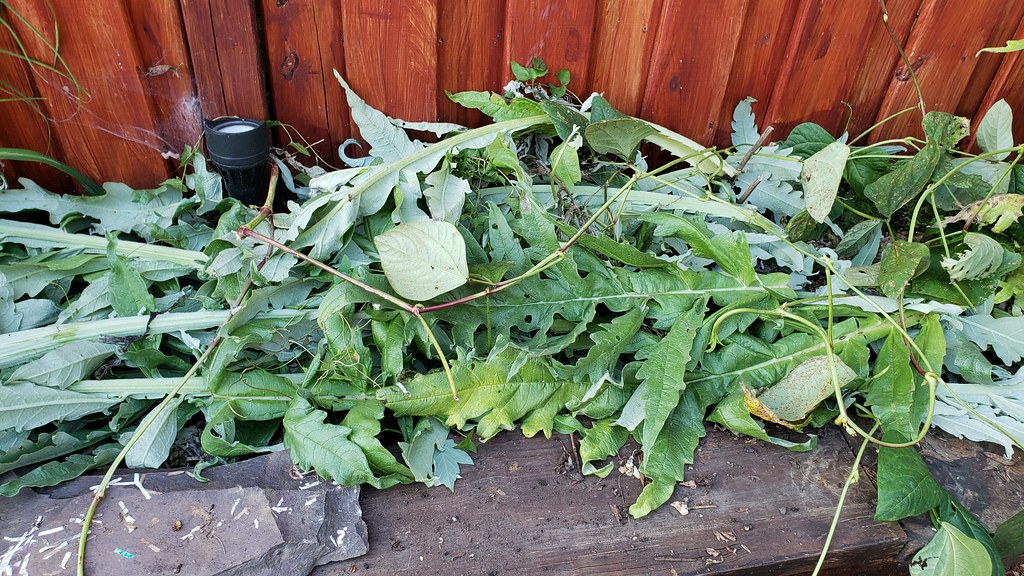
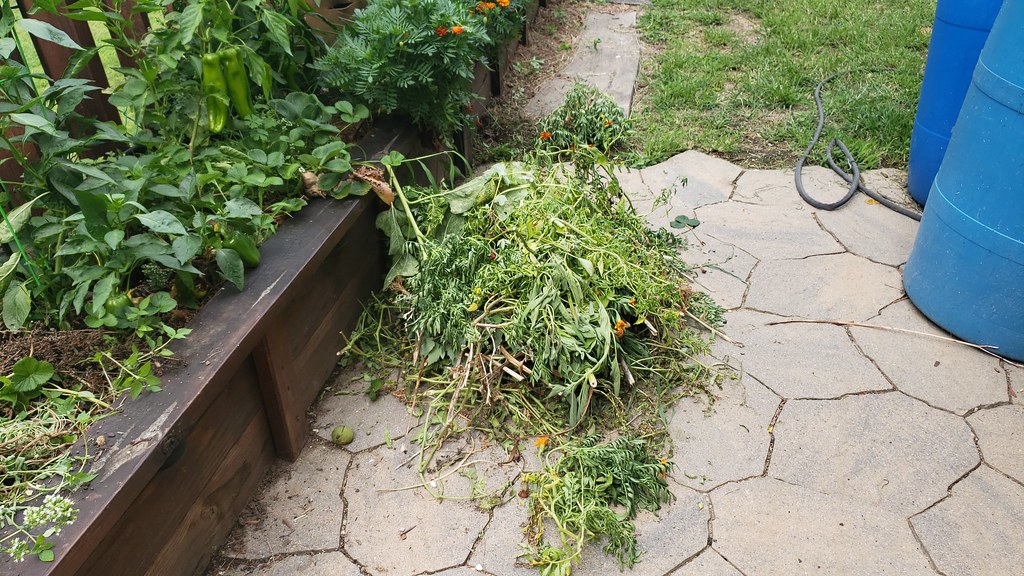
Yes! even weeds.
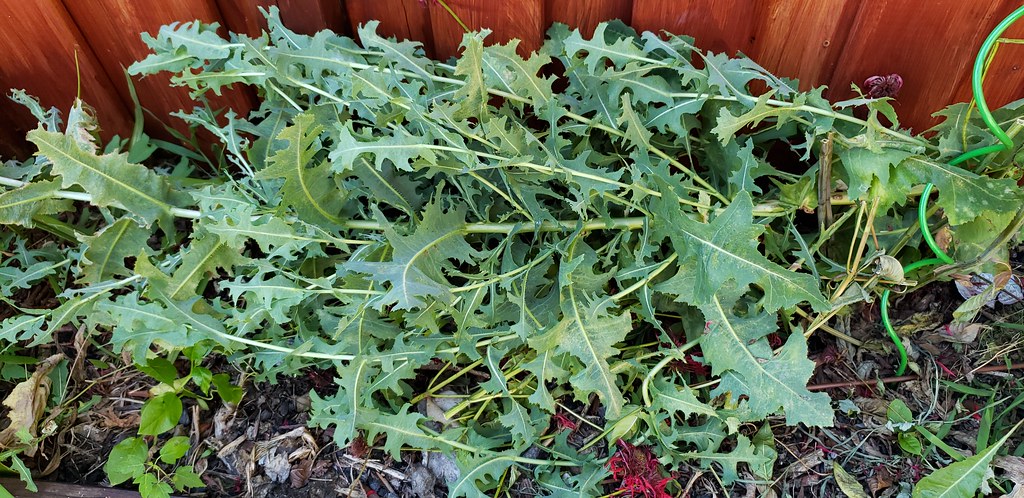
Kitchen scraps.

Water lettuce
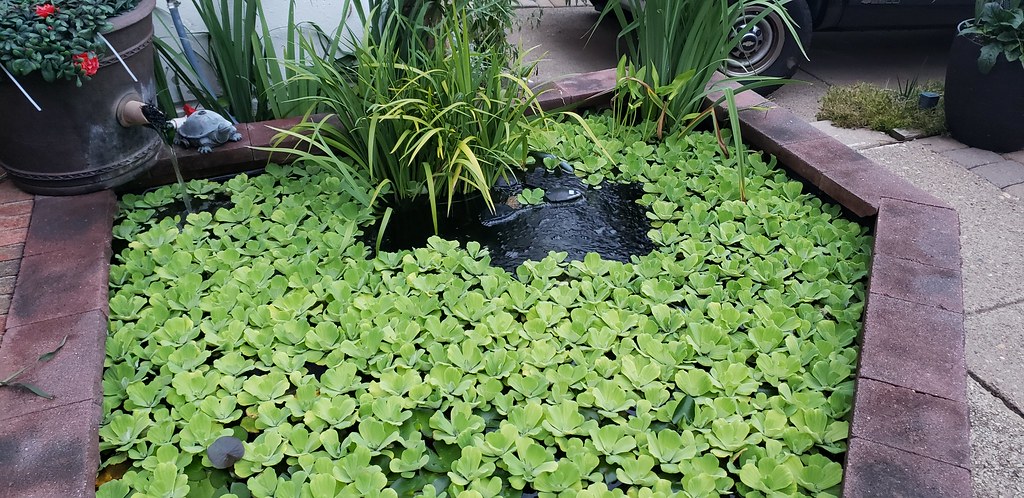
Pine needles and leaves
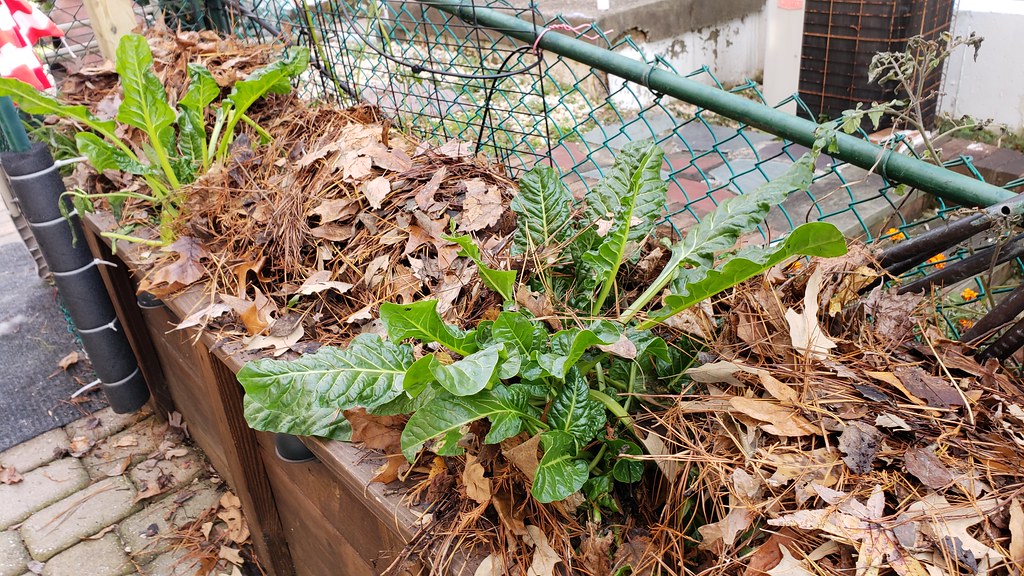
Rabbit manure/bedding
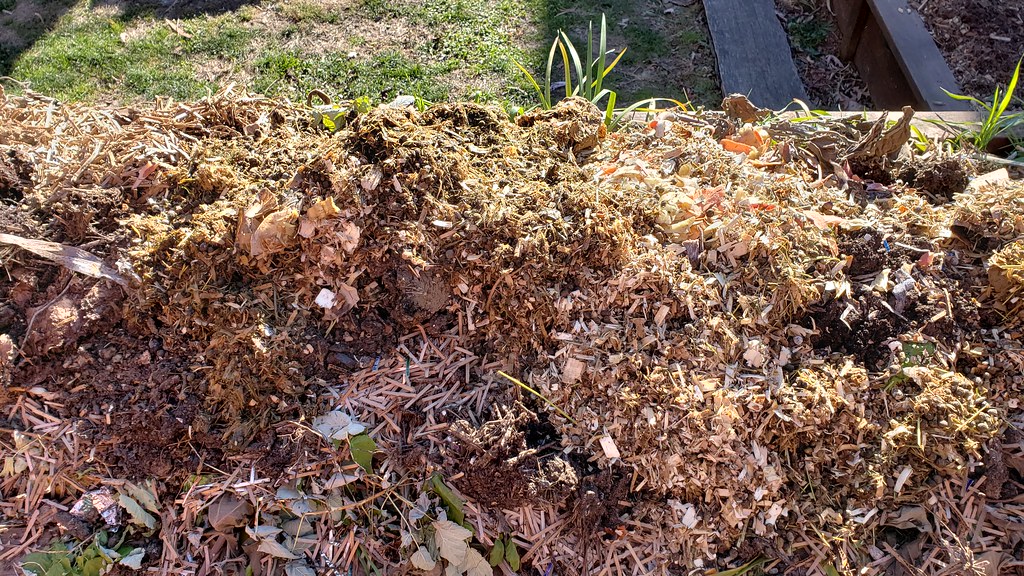
Ashes, sparingly spread on top of beds.
Bio-char, sparingly spread on top of beds.
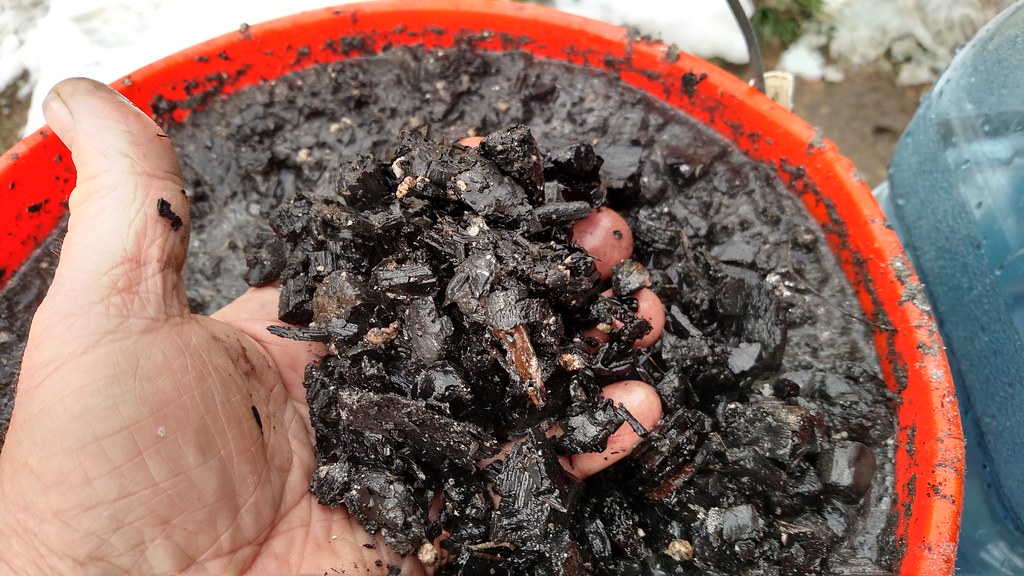
charged with urea of course
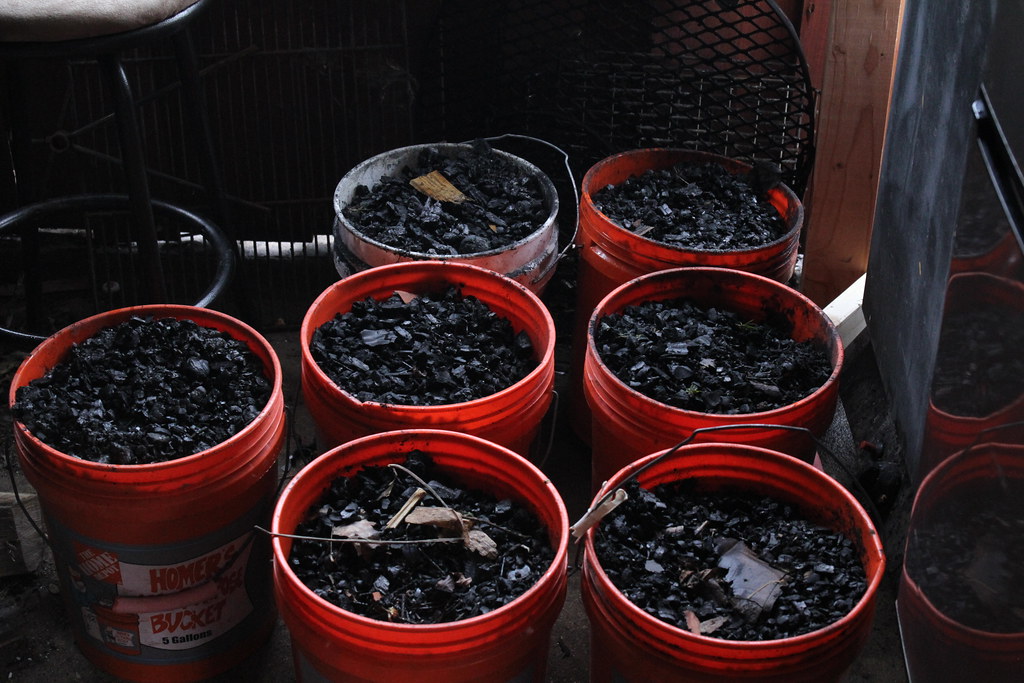
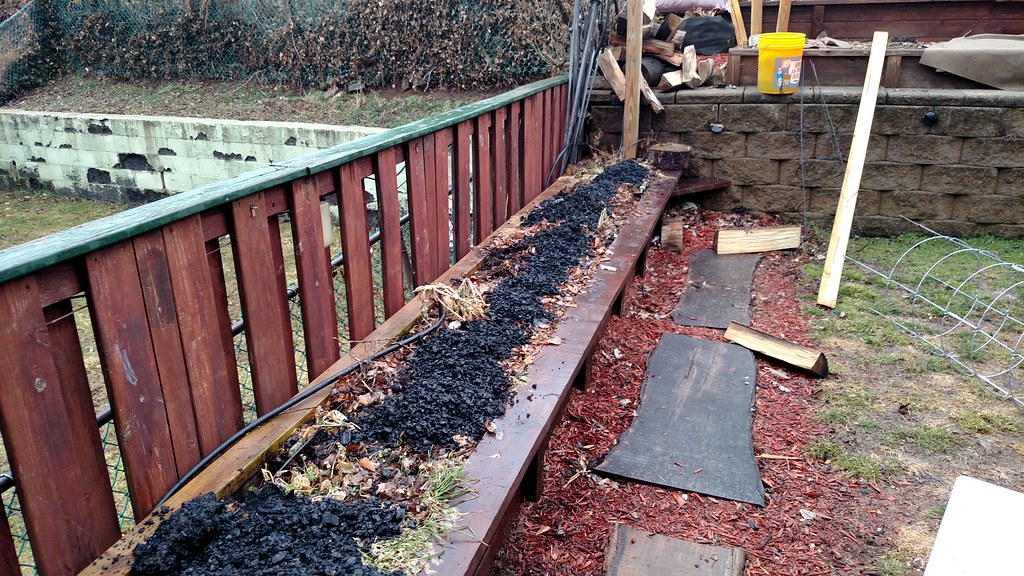
Arborvitae trimmings.
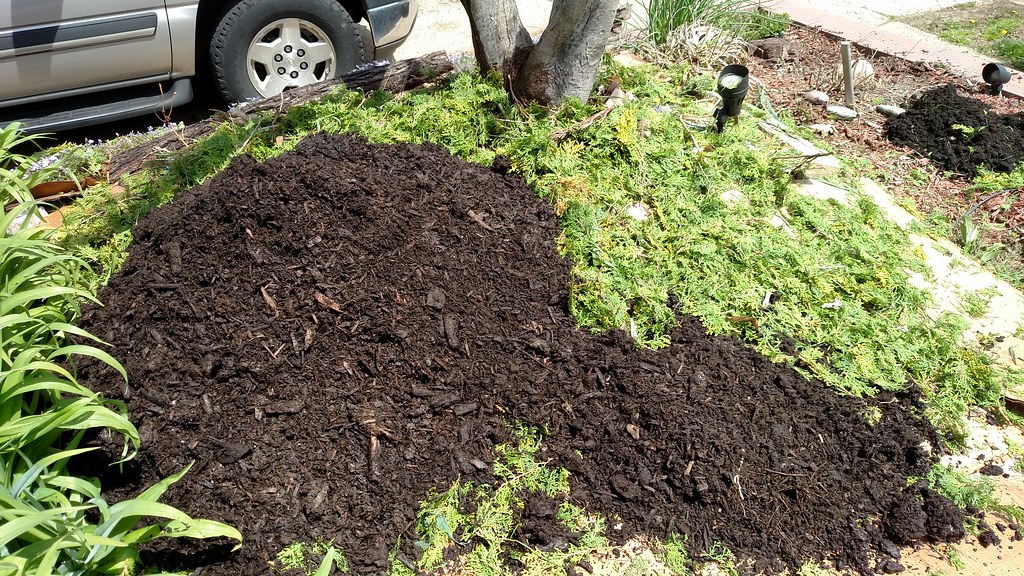
Leaves

Wood mulch
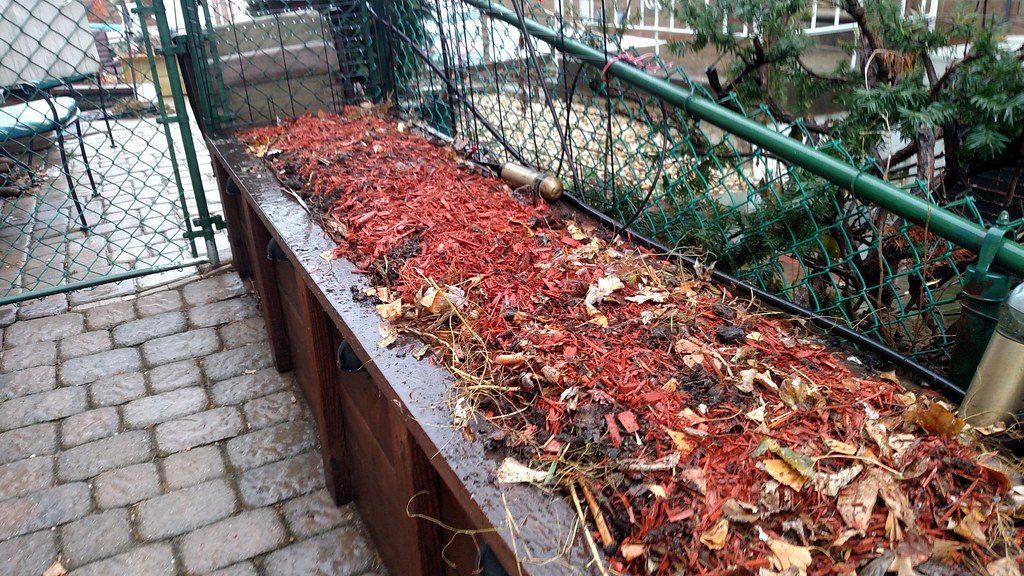
Compost and Mulch from the recycle center.
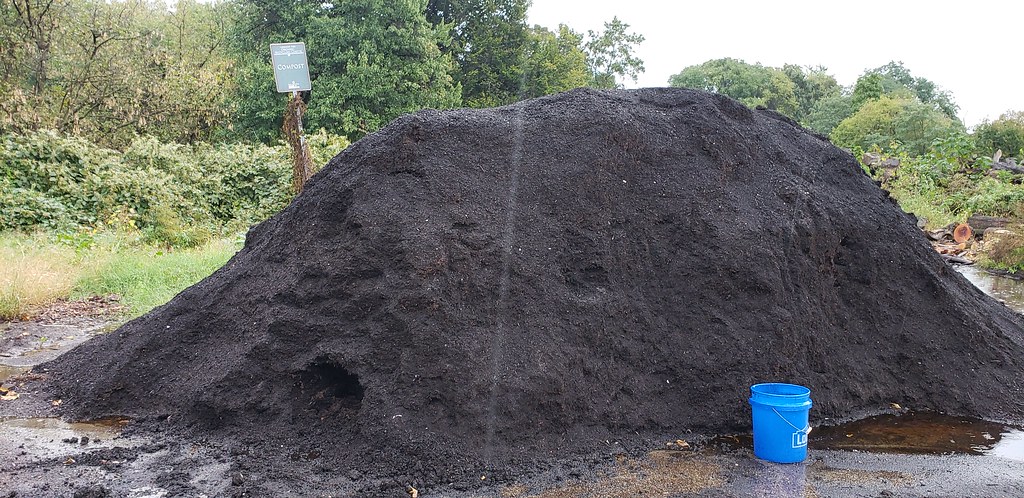
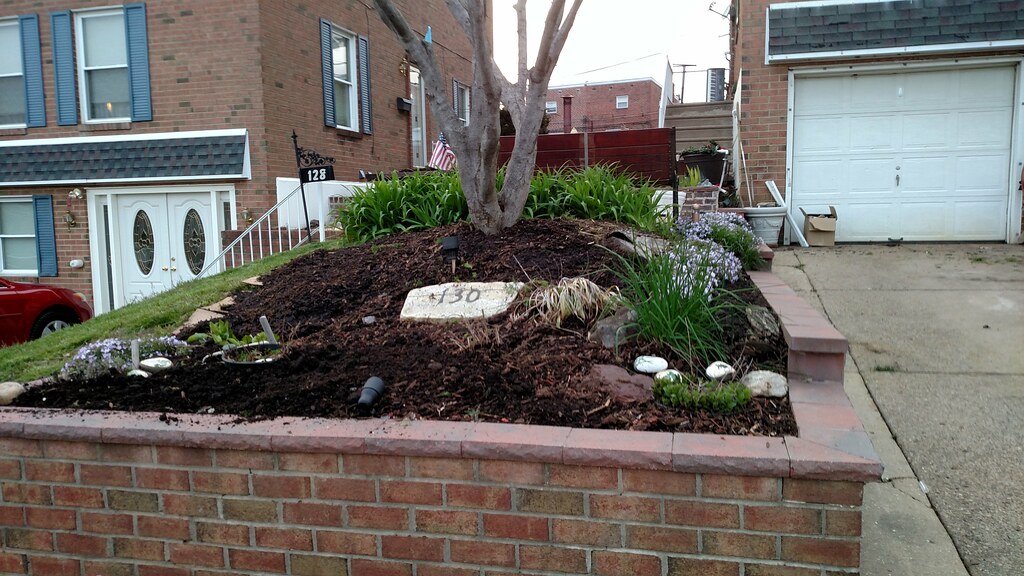
Wood
Straw
Hair
Rabbit manure (Manure, Charged Bio-char, Coffee Grounds mix)
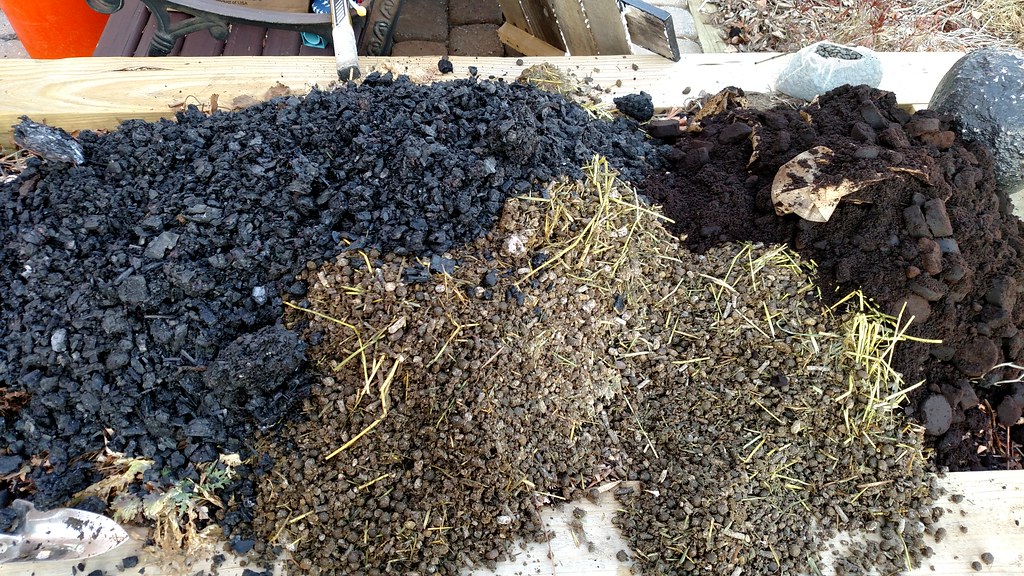
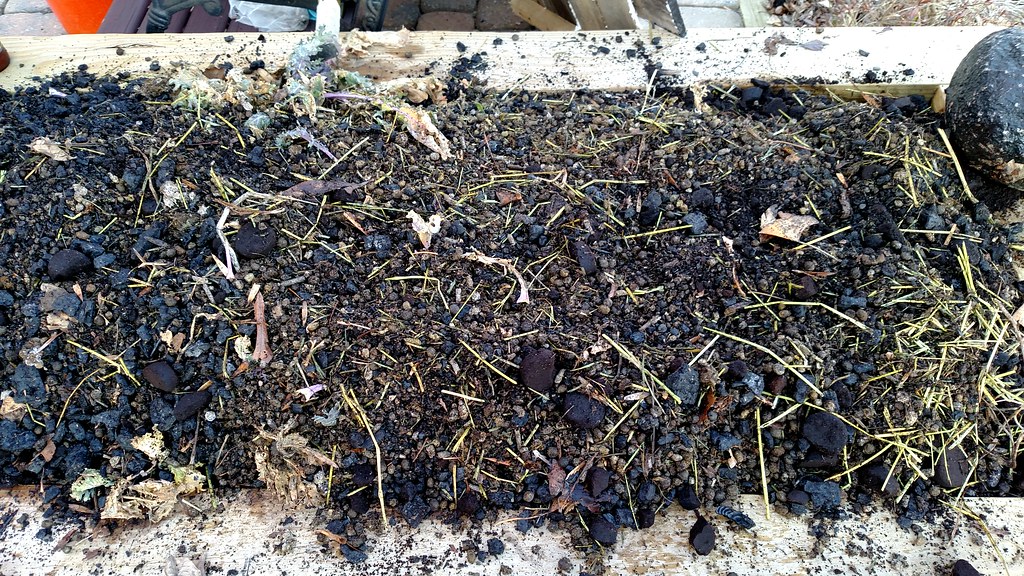
Coffee Grounds
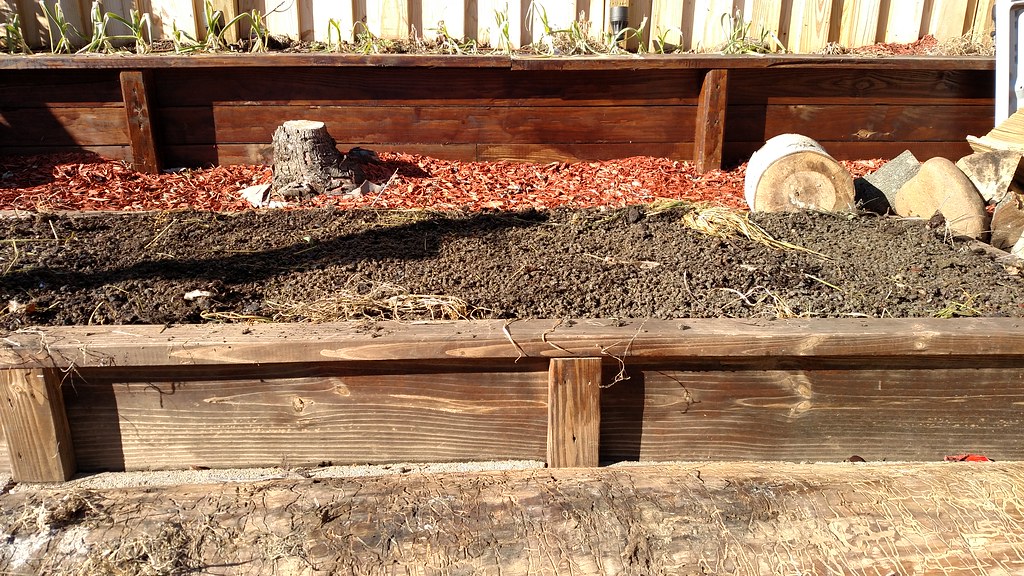
Logs
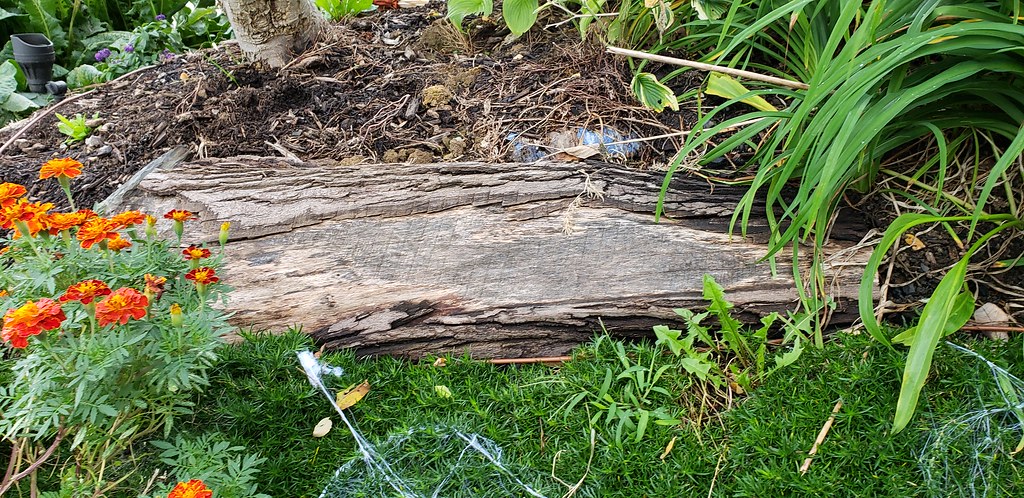
Oregano
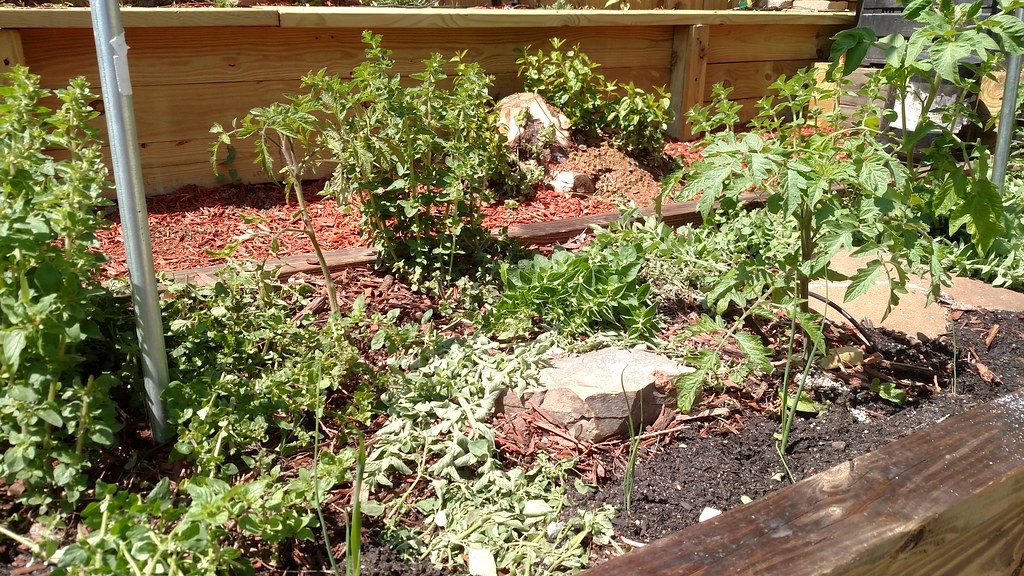
Rocks
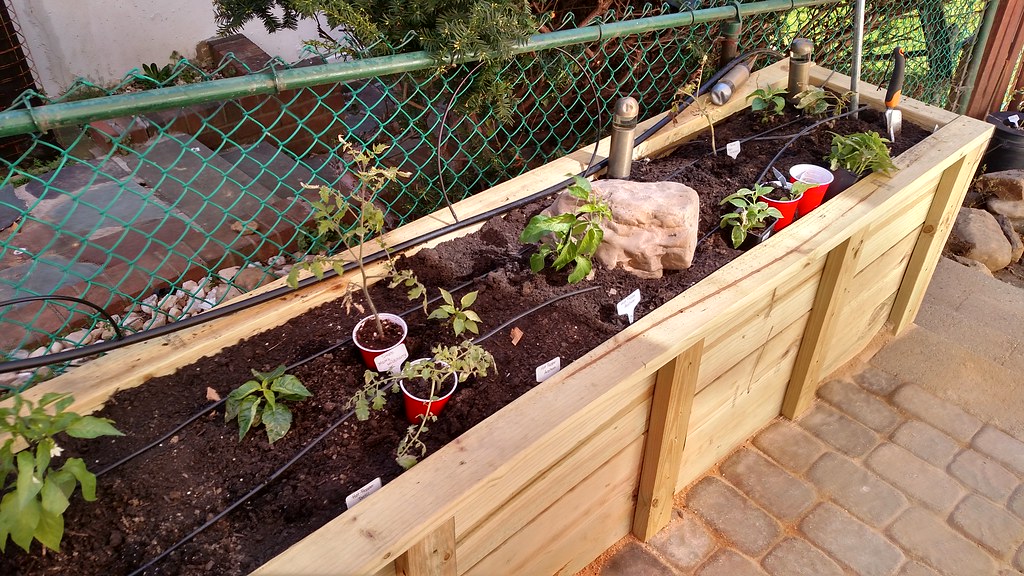
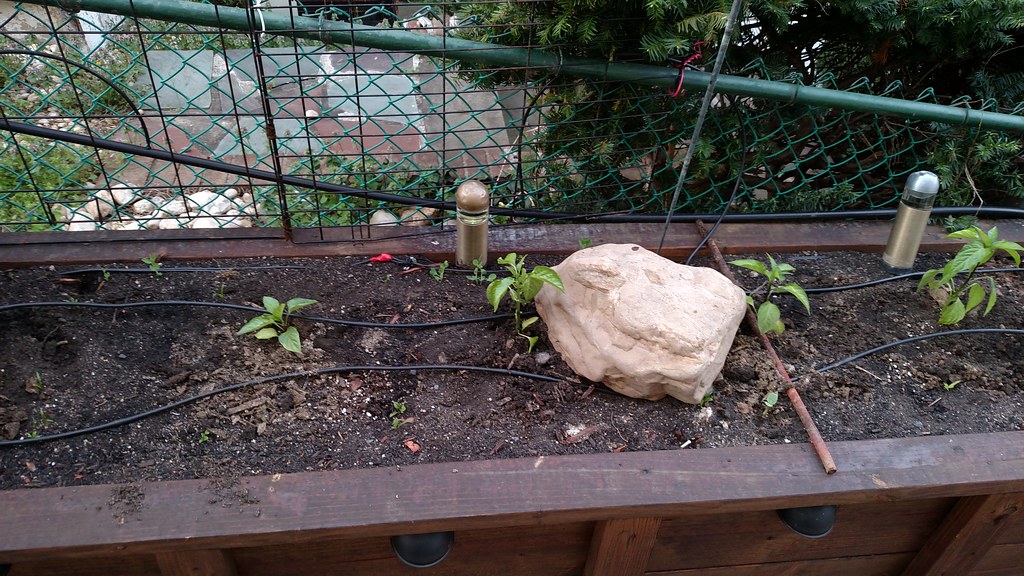
Any trimmings from the garden or yard are placed back on top of the beds as mulch, even fruits or veggies that are not up to par are tossed on top of the beds, I try not to remove any thing from the beds.
I have found that the simple act of being pickier with the harvest and tossing the under achievers back on the beds has nullified any guilt associated with wasting fruits or veggies, however I do get stingy with my end of season crops.
Bio-char along with urea, Rabbit manure, animal bedding and coffee grounds are added whenever they become available. (Also ashes, but I consider ashes a fertilizer)
I consider my cover crops a mulch as well.
Cover crops, even when they die back, will leave a network of intact roots for a good bit.
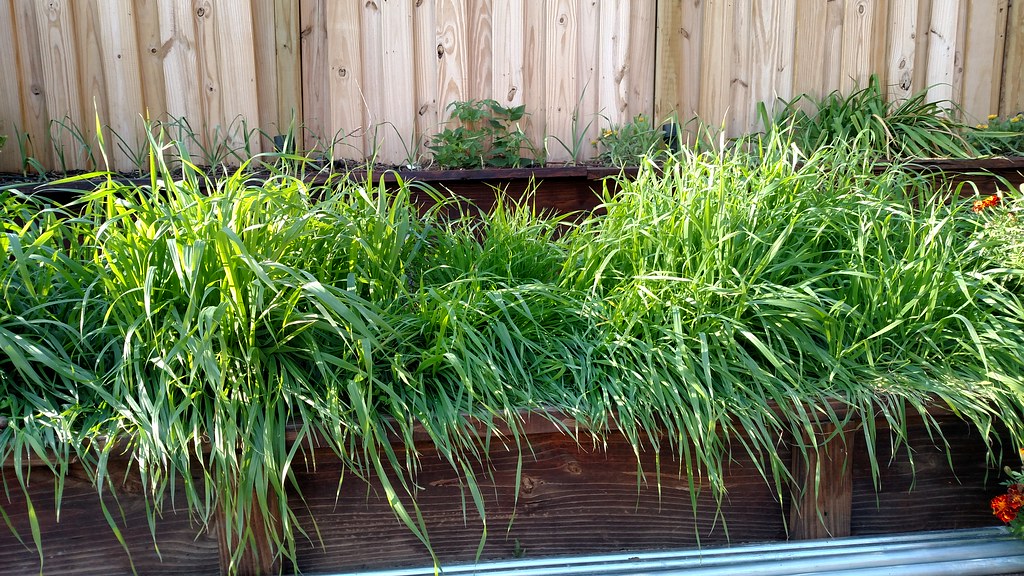
Here is a bed being planted with cover crops.
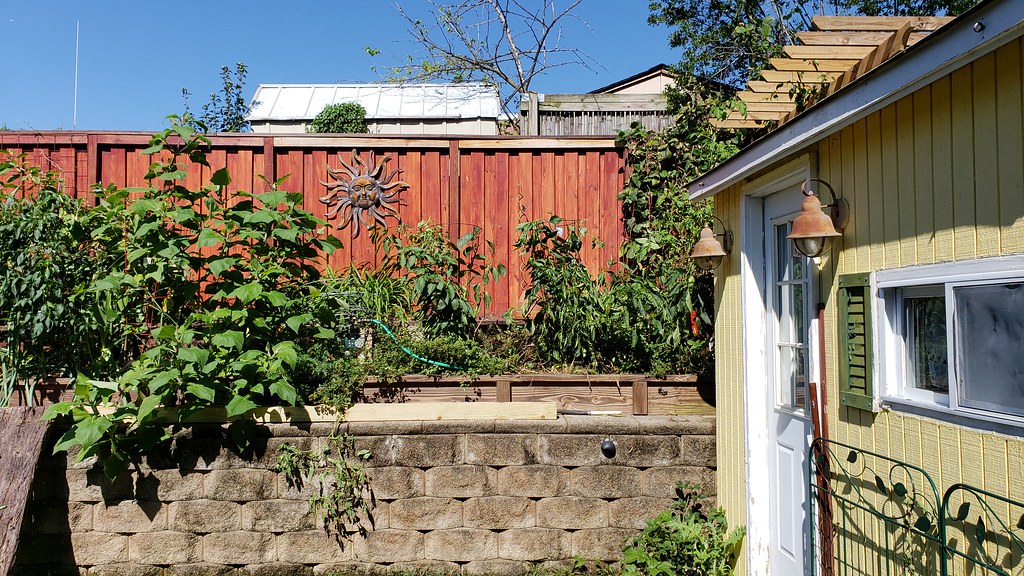
The whole bed is chopped in place, roots stay intact.
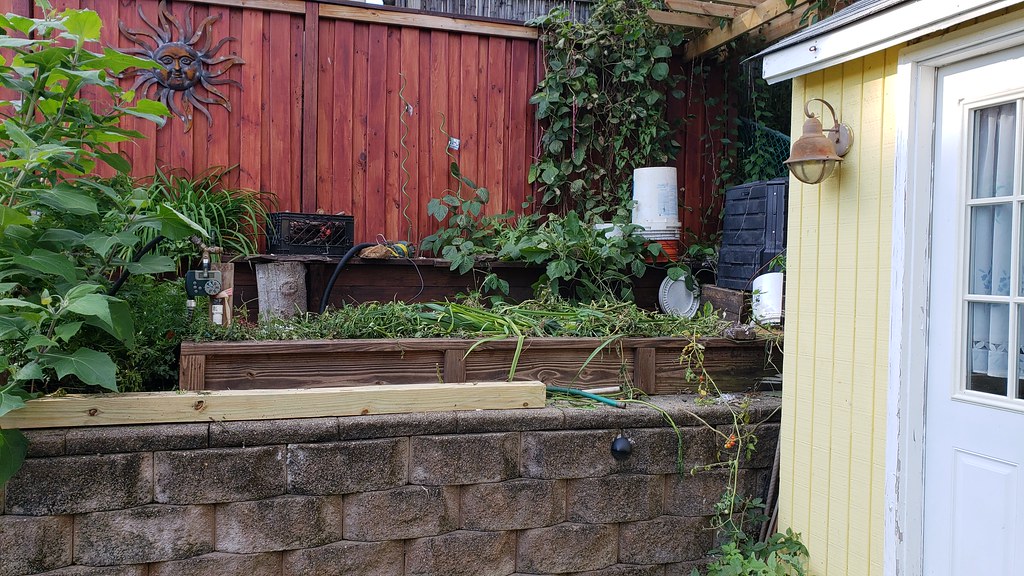
Other items may be placed on top, in this case, water lettuce from the pond.
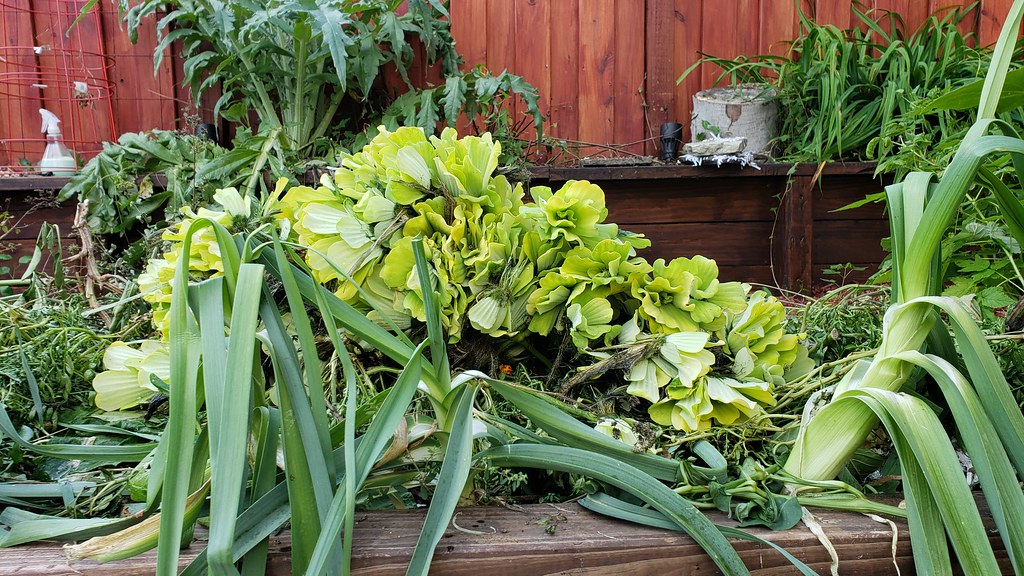

Topped with some mulch/compost
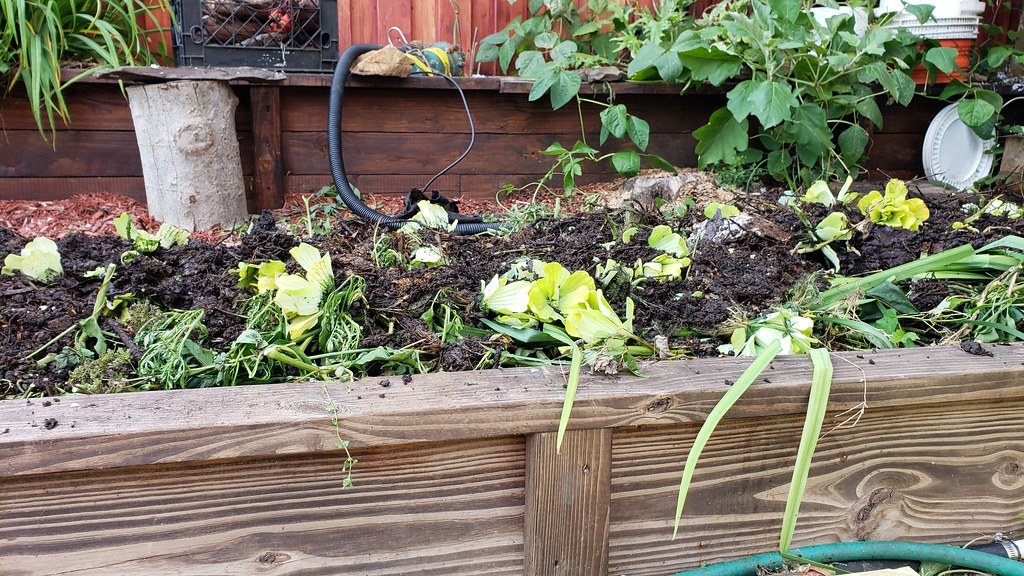
Planted with oats and crimson clover.
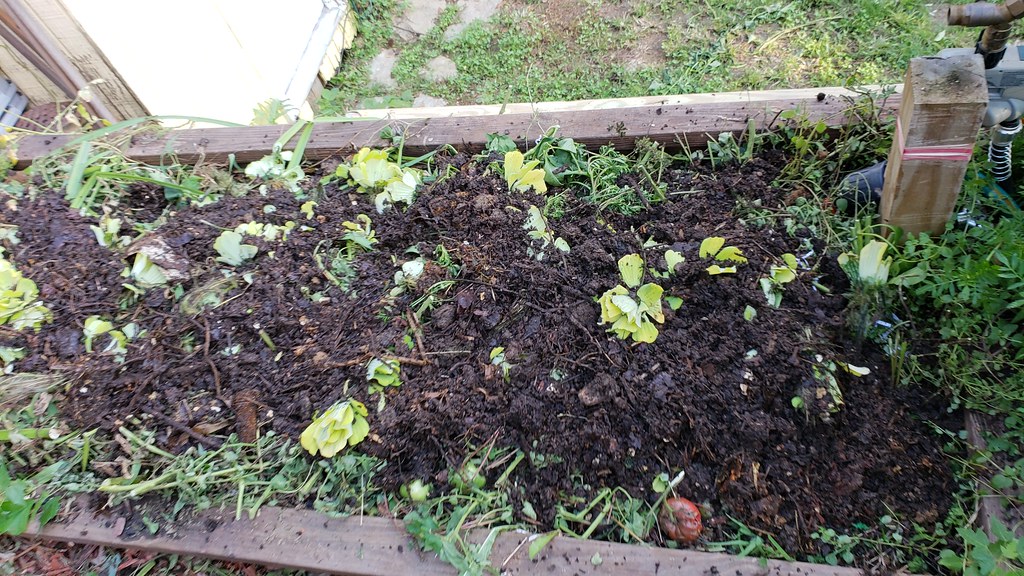
Bio-char is added, but would have been better to add prior to the mulch/compost.
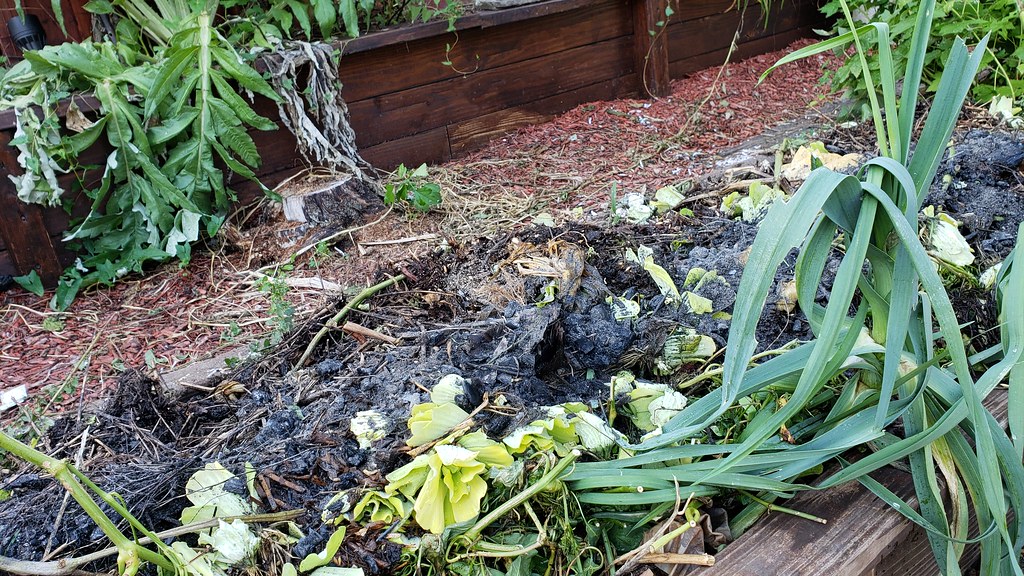
Here's a before and after of another bed, these were tomato plants that were chopped and dropped.
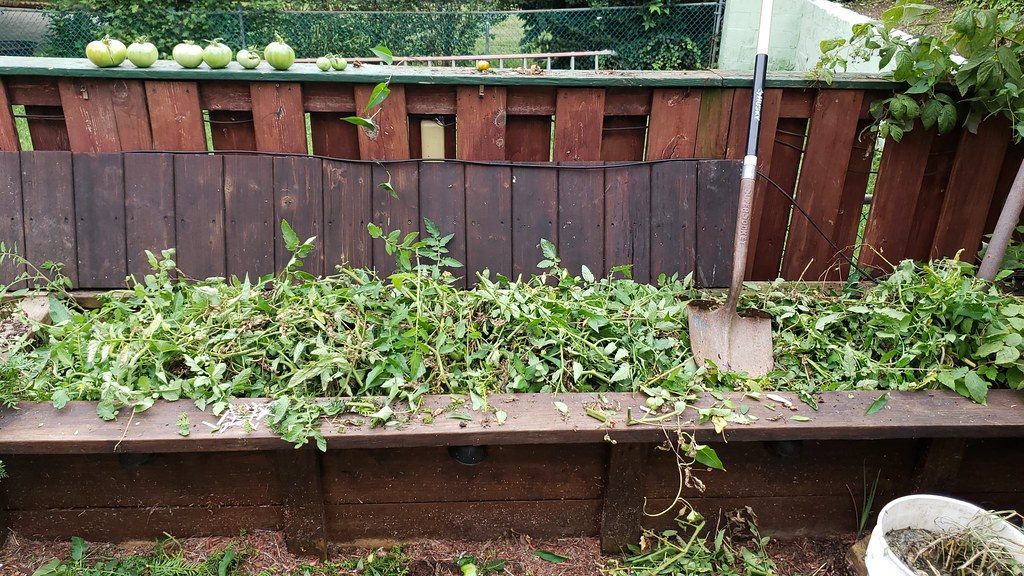
I layered some shredded cardboard and some spent potting mix to allow the cover crop seeds to germinate.
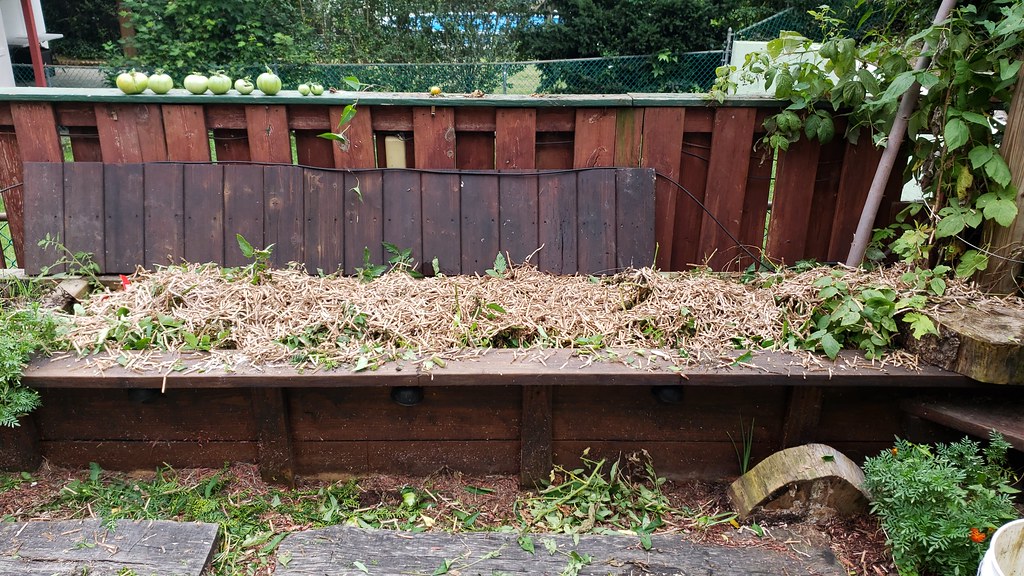
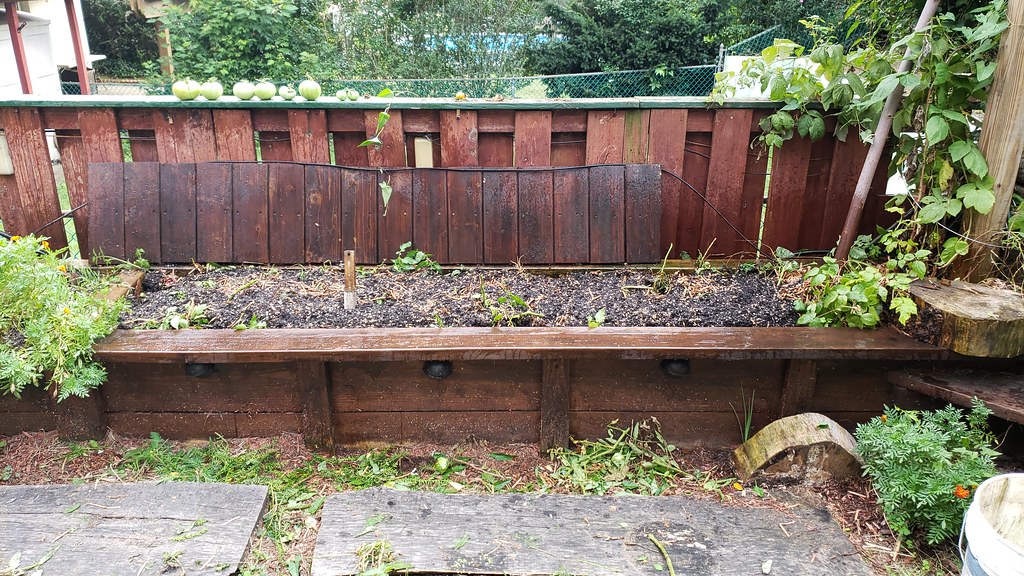
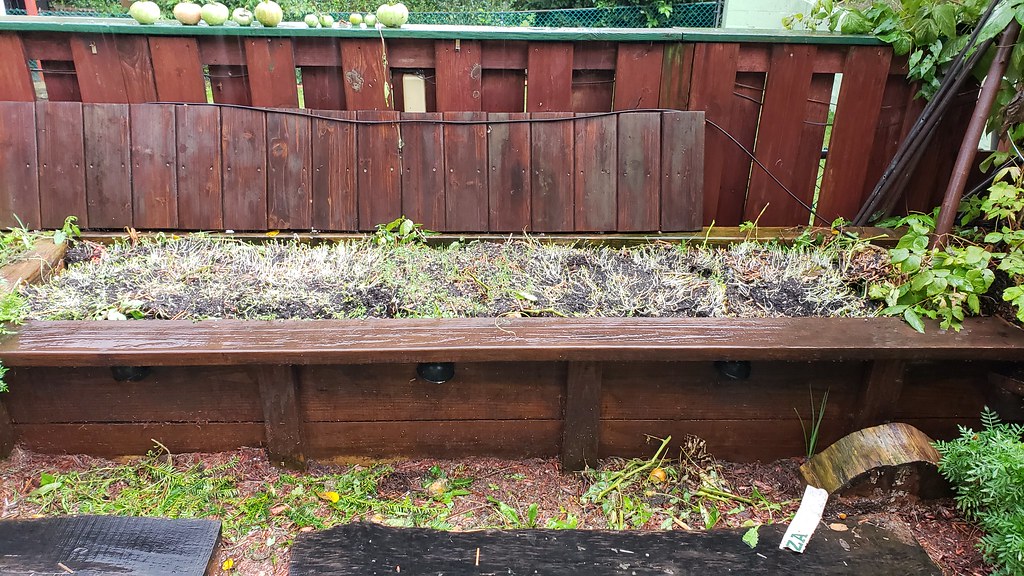
Cover crops are growing nicely after 4 weeks.
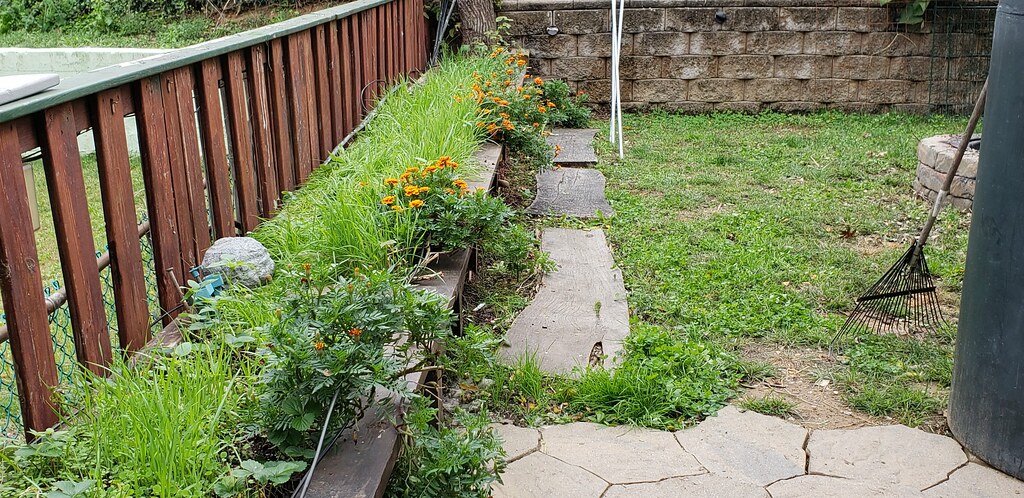
I'm a bit pickier with the front yard as to not upset the neighbors, lol.

Bagged mulch. (Yeah, I know!!!)
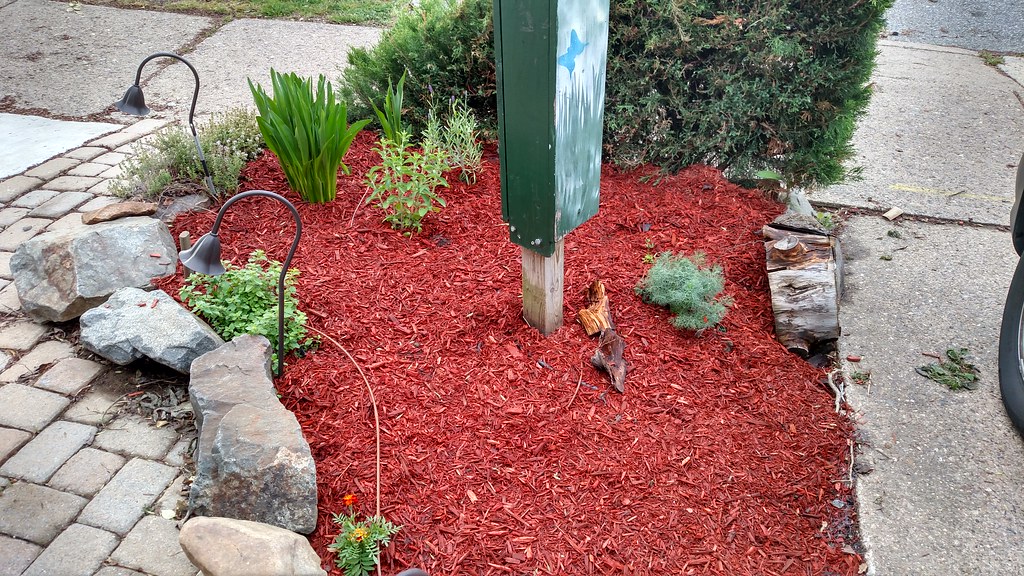
Here are what the beds look like when a cover crop is planted.
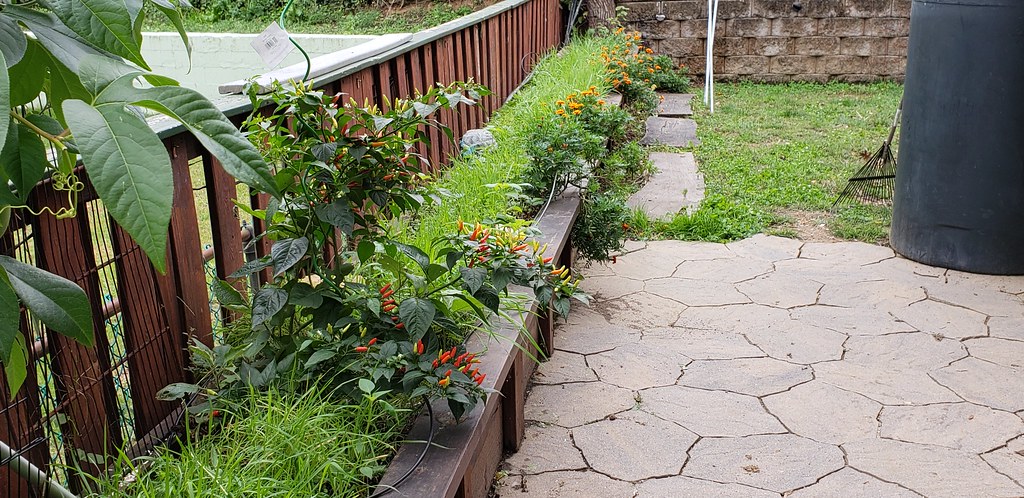
I sometimes get mulch and compost from the recycle center.
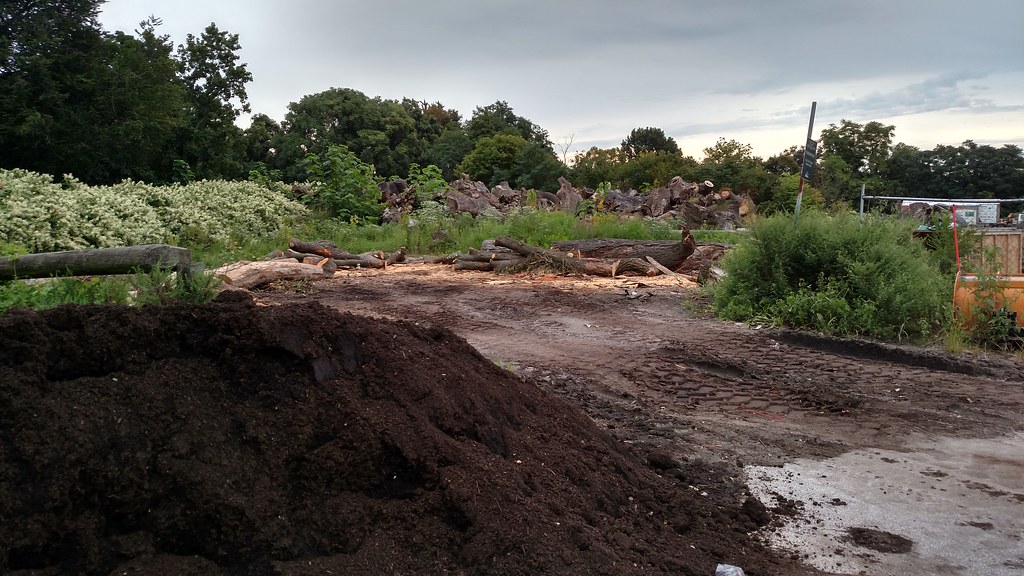
When do I mulch?
I never stop mulching.
Disclaimer. All the above under "Mulching and Mulch" is based on personal opinion and your results may differ.
My ramblings on Chop and Drop
CLEAN OUT THE BED vs. CHOP AND DROP
... for the urban gardener.
First off, what is Chop and Drop? My use of the chop and drop method is simply dropping the trimmings directly in the bed of the plant being trimmed, usually around the base of the plant.
This includes weeds as well. Sometimes I will let the weeds grow until right before they set seeds then chop and drop in place.
There are plants that are grown specifically for this task but the only plant I grow specifically as a chop and drop is Comfrey.
OK, what about chop and drop as a fall cleanup?
I use the chop and drop method in my gardens all season and for fall cleanup, nothing is removed from these beds including weeds and less than desirable fruits and vegetables, everything is just layered in place.
When I'm out doing my rounds in the garden, trimming and such, and I come across fruits and veggies that aren't up to snuff they are put back in the bed, this reduces guilt factor too as I don't feel that it is being wasted. The occasional blemished fruit will makes its way to the turtles to snack on.
My philosophy is to put back more than I take out and that is during the growing season as well as at the end of the season. I also add to the beds the entire, winter once the cover crops die back.
For my flower gardens, I try to leave some things as is for the wildlife, pruning and cleanup is minimal.
I have been using the chop and drop method for a while and there is a drawback of this method, it can look like hell, so I try to find a balance for my front gardens. For the front gardens I will let the plants die back and cover with a mulch.
There may be circumstances where cleaning out a bed for fall cleanup may be necessary such as a pest infestation, persistent disease, fungus or a virus, but I have yet to come across this situation and hopefully it doesn't come back to bite me in the @ss.
I have read so much regurgitated information on this subject that it has me annoyed. Nowhere do I see any true research about this, whether it be in favor of one or the other and that's fine, but what urks me, is that a lot of information on these sites start out with stuff like "Spring garden cleanup done RIGHT", eh.. excuse me but where is your Ph.D. in Soil Science!!!
Most internet searches on this subject lean towards the "remove everything from the bed". Why? due to possibility of harboring bad insects and disease through the winter. Well, what about the beneficial insects and food for wildlife?
So I call BS on this!
What about all the nutrients and mulch potential to protect the beds using the chop and drop method?
"Oh, no problem there, because we compost it"!!!
Why? Wouldn't it make more sense to leave it be?
"Well... you have to get a hot compost to kill the seeds and bad bacteria and stuff".
Again I call BS.
I can see if you have an infestation of a specific pest or a serious disease present, but most of the time chop and drop is fine.
I do see some folks suggesting to leave beds alone till spring, mainly for ornamental gardens, some say that this greatly benefits the wildlife in the winter months.
Everyone has their own way of doing things and I respect that and won't argue which way is the RIGHT or WRONG way, do what works for you, I just get tired of hearing it over and over again just because that has been the general consensus and it's almost preached!
Just like the constantly regurgitated warnings of using PT wood in edible gardens. Sometimes I believe it is just unintentional fearmongering.
DISCUSSING CHOP AND DROP FURTHER...
A lot of terms go hand in hand, what do I mean by that? Well let me show you.
Here is an example of a "chop and drop" that is also; mulching, sheet mulching, composting in place, In situ composting, no till gardening, no dig gardening, lazy gardening, lasagna gardening etc....
Bed ready for fall cleanup.
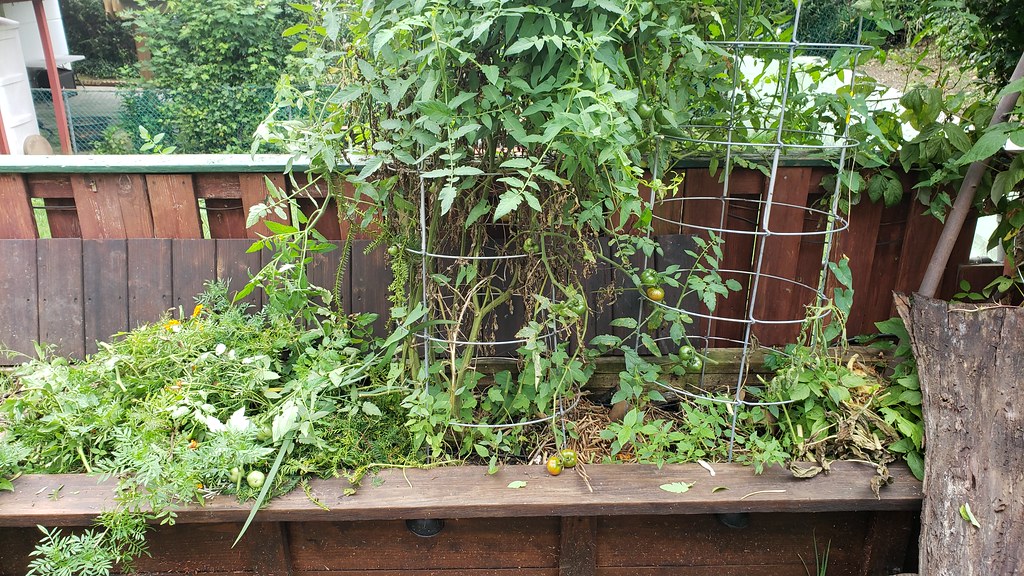
Plants are cut at the soil surface, chopped and dropped. If I stop here, it is mulch!

Bucket of weeds that were soaking in rainwater for a week are added.
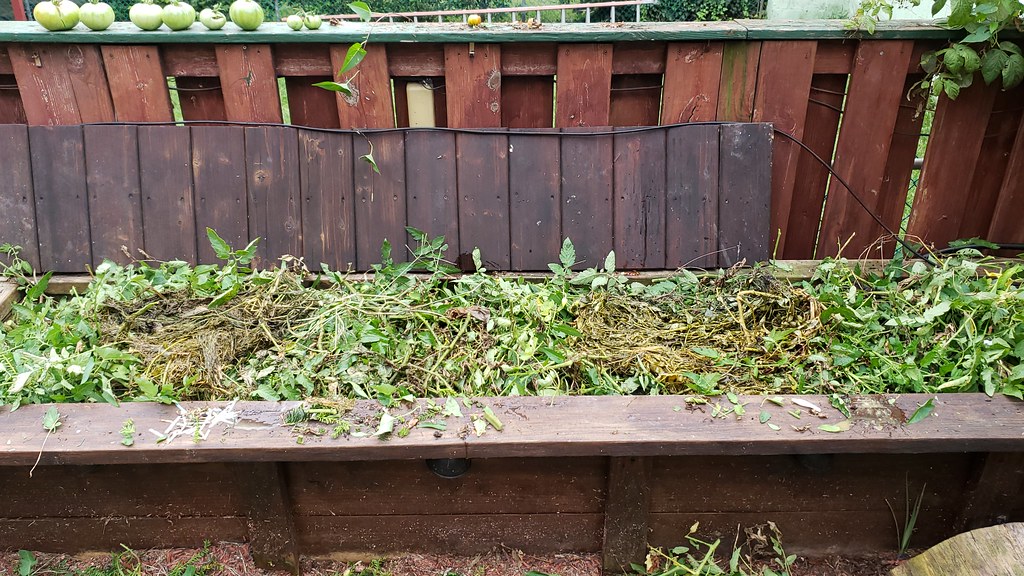
Some shredded cardboard is added and watered.

Some spent potting mix is added.
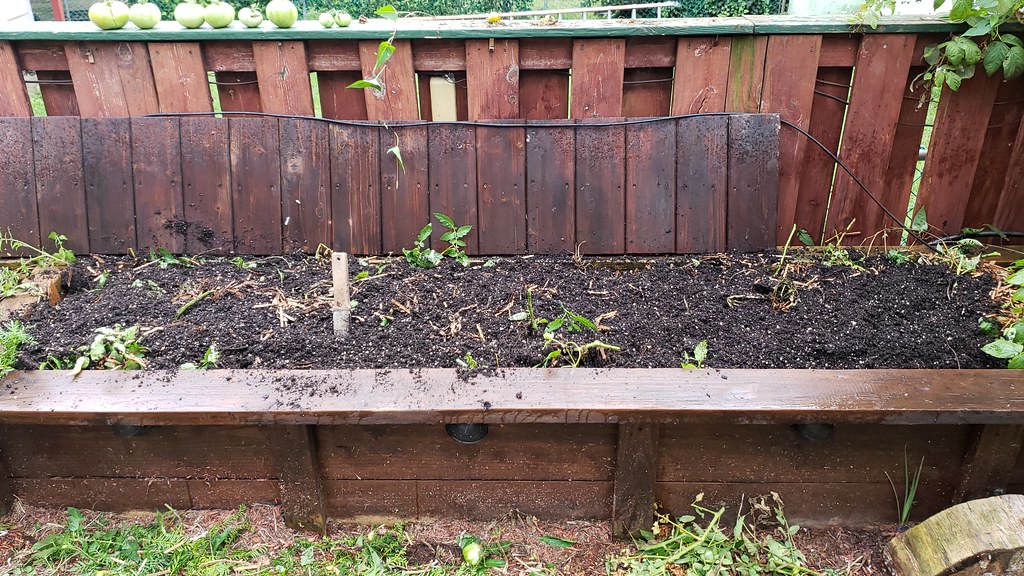
seeded with a cover crop and watered.
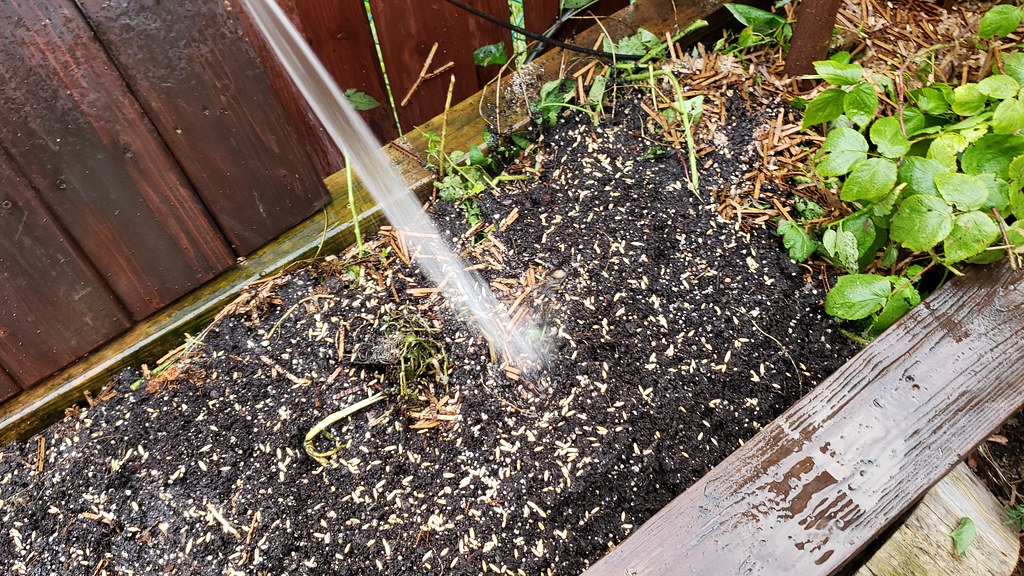
Now the cover crop becomes the mulch (living mulch) and everything below that is composting.
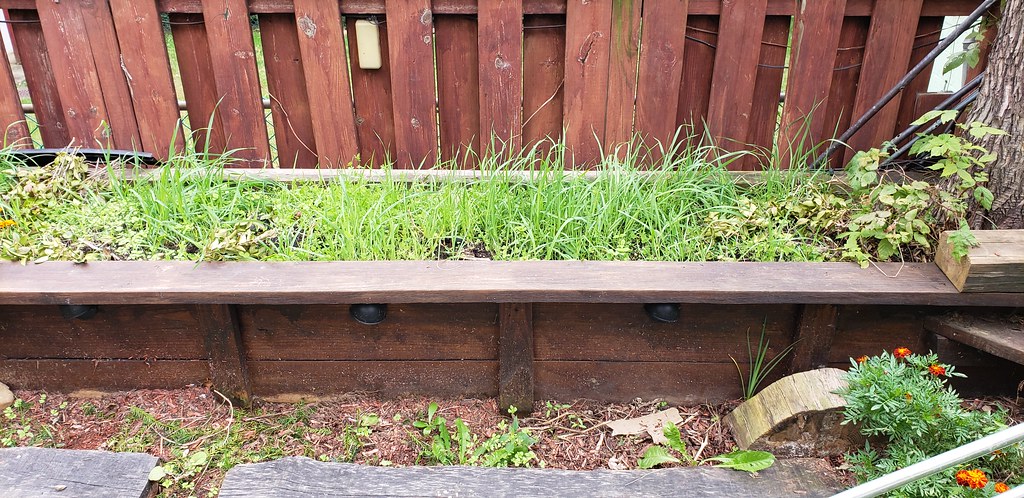
The cover crop dies back and provides a protective covering at this point the bed is ready to overwinter, However sometimes I will keep adding to the bed, topping with kitchen scraps, cardboard, leaves and other materials. Now the cover crop becomes the compost and the leaves and other materials become the winter mulch.
Disclaimer. All the above is my opinion only and based on my personal experience in my small urban garden and no testing in labs have been done, your results may vary.
COLORED MULCH
January 15th, 2018
There appears to be a lot of misinformation on the web regarding colored mulch and it seems colored mulches are all usually lumped together.
If one was to do a bit of googling on the subject, they would think that using colored mulch will kill you and your family, have your neighbors fire-bomb your house or destroy the planet.
This article is just about the safety of using the specific bagged color mulches as described below, not about ALL colored mulches, the carbon footprint, how unnatural and gaudy bagged colored mulches are, robbing nitrogen from the soil, quality of the mulch, etc..., these are all topics of discussion for another day.
OK Back on topic,
Most sites regurgitate the same misinformation, "Colored mulch may contain CCA, colored mulch is made up of old wood pallets , demolished buildings and or pressure treated woods. Maybe some of this is true, but its not accurate to lump all colored mulches together.
There are also sites that do give some good information and tell you that some colored mulches are safe but they don't tell you how to determine what is safe and what isn't, basically they just tell you to do your homework.
In the past I have done my homework so to speak and on one occasion I ordered a cubic yard of mulch to be delivered and half of it has paint all over it with quite a few other things mixed in mainly metals and glass, that was the last time I ordered mulch from a landscaper. I know foreign objects will find their way into some of these mulches but what I experienced was unacceptable.
I try not to bagged mulch anymore but when I use Bagged colored mulches, I used different colors most of the time and although the color is a bit "too much" on like say the "red" in the beginning, I like how it ages after a year or so, but that is my opinion.
I am the type of person that needs to find out things for myself, I try not to give into the same old information regurgitated over and over and from my experience I posted above, tells me, I can't trust suppliers either. With that in mind, I did a bit of research and wrote to the company that certifies the mulch I currently purchase. The company is called The Mulch and Soil Council.
Here is a quip from The Mulch and Soil Council's website about Certification
The MSC Product Certification Program was developed to help consumers, retailers, regulators and others identify products that conform to the Voluntary Uniform Product Guidelines for Horticultural Mulches, Growing Media and Landscape Soils (VUPG). In 2003, the MSC launched its Product Certification Program. Products that pass the review and testing requirements and comply with ongoing audit testing of products in retail markets earn the badge of the MSC certification logo for their packaging.
So exactly how do I determine if the mulch is safe? I decided to contact "The Mulch and Soil Council" via e-mail.
Dear Sirs,
I am trying to find out definitive information on two products sold at a few of the Big Box Stores
Vigoro Colored Mulch (red)
Scotts Earthgro Mulch (Red)
Do these products contain any recycled wood at all in the form of construction materials, pallets, milled lumbers and the like?
Both are a certified products of the Mulch and Soil Council, but there are no specifics to what the product contains.
This is a quip from the Mulch and Soil Council website, but I don't see anything about what the product is actually made from
"To assist regulators, retailers and consumers in determining what products conform to industry guidelines, the MSC conducts a voluntary product certification program. Products qualifying for certification must pass product and label review, laboratory testing and periodic field inspection in order to use the MSC certification mark on bags".
I really appreciate your valued time,
Me
Then a quick reply from the Mulch and Soil Council.
Dear Mr. Me:
Thank you for your inquiry. All MSC certified products are required to have an ingredient statement on the label. While it may not stand out prominently and you may have to read the “small” type, it MUST be there. An ingredient statement is a required element in the industry standards, and Its absence is an actionable violation of the certification agreement. We should note that if the product name is sufficiently descriptive of the product, i.e., shredded hardwood mulch, no additional ingredient statement is required.
Since many labels apply to products that are regionally sourced, it may list "natural wood products" or "forest products" as a generic category for virgin wood. Such products are generally made from hardwood or pine species.
Pallet grindings, construction materials, and any treated wood and/or wood products reclaimed from post consumer or post industrial uses must be labeled “reprocessed wood" or “recycled wood" in its ingredient statement. Treated wood containing CCA (Chromated Copper Arsenate) is not allowed in certified products.
You mentioned "milled lumbers” which we include in the virgin wood product category IF the following restrictions are met: 1. It is untreated wood 2. It represents mill scrap that has not been circulated as a consumer or industrial product.
For example, a pallet mill can sell its scrap from newly constructed but untreated and unsold/uncirculated pallets as virgin wood since the wood has not been exposed to potential contaminants. The same would apply to other wood products like shingle, fence, or wood truss manufacturers provided the same restrictions are met.
I hope this answers your question. If you have any further queries, please let me know.
Sincerely,
Robert C. LaGasse
Executive Director
Mulch & Soil Council
7809 FM 179
Shallowater, TX 79363
Tel: 806.832.1810
Fax: 806.832.5244
E-mail: execdir@mulchandsoilcouncil.org
And a follow up on the dyes used in these colored mulches.
Dear Me:
The dyes are ferric oxide for red, carbon black and various combinations for browns. These are essentially the same components used in cosmetics and are below any minimum safety reporting requirement of the Environmental Protection Agency. These dyes represent no danger to people, plants, animals or the environment.
Thanks,
Bob
Robert C. LaGasse
Executive Director
Mulch & Soil Council
7809 FM 179
Shallowater, TX 79363
Tel: 806.832.1810
Fax: 806.832.5244
E-mail: execdir@mulchandsoilcouncil.org
OK, Thank-you Bob from Mulch and Soil Council
With all that said I wanted to share what I know factually through written research only and not a lab, so take it as such, hopefully this will thwart any fears some may have of buying bagged mulch .
I used to purchase the following types of Bagged mulch Scotts Earthgro (Red) and Old Castle Vigoro (Red) from Home Depot. Below is how I determine if it is safe for may garden, yes veggies as well as flowers.
Look for the MSC Certification. Once you see this certification look for the ingredients statement. Just know that the Mulch and Soil Council do not certify against the possibility of pesticides in the mulch.

Then look at the ingredients, you want to see the wording "Contains Natural Forest Products"
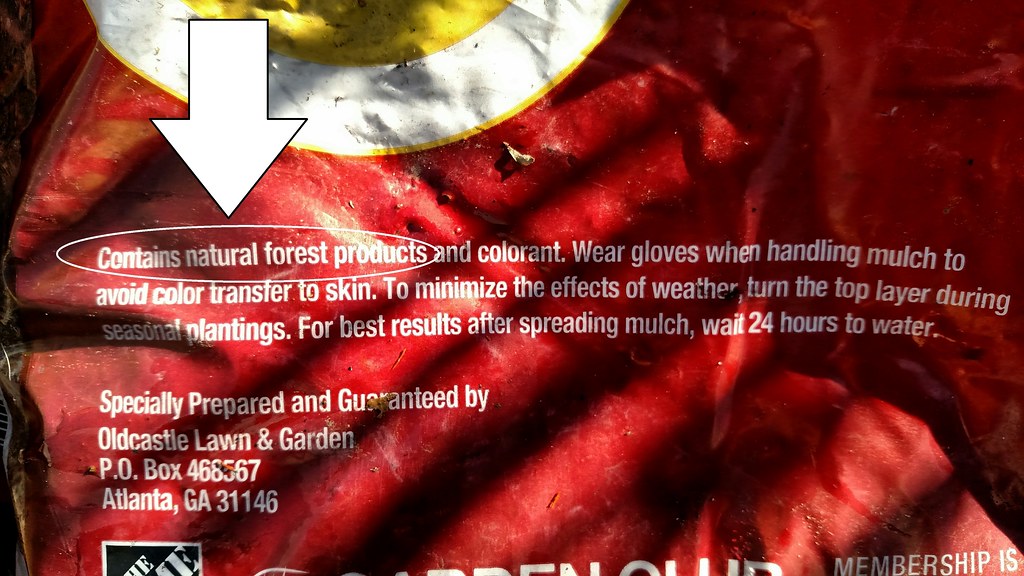
Now, there is always a chance of some unscrupulous activity going on and the only way to be 100% sure is to have every bag you purchase tested by a lab, and we know that is never going to happen, so take a bit of comfort in knowing that MSC certified bags of mulch that state "Natural Forest Products" will give you piece of mind knowing they are safe to use in food gardens.
Disclaimer. All the above under "Colored Mulch" is based on research via written communication and no testing in labs have been done.
October 19th, 2018
rev. 12/9/19
Composting, Mulching and Mulch
My ramblings (opinion) on compost, Mulching and Mulch.
Composting
Bin Composting
I use a few methods of composting, one of my methods is a compost bin, the dimensions of my compost bin are 28"L x 28"W x 32" and modified to 42" height.
Almost everything I have read on the internet (you know, the place that is always correct) says that you need at least 27 cubic feet or 9 cubic yards, 36" x 36" x 36" for a hot compost. I agree the bigger the better but this is just regurgitated info that some folks keep spewing out and it's nonsense.
I have no problem getting a hot compost when I try, however, I won't discuss hot compost because frankly I don't have the time or ambition of making a hot compost, I have enough stuff in the garden to worry about and don't need another thing to worry about.
I cold compost and on occasion, when I inadvertently get the mix right, it becomes a hot compost.
I don't turn, aerate or moisten, I just keep piling it up and dig out the compost from the bottom...that's it!
Now lets discuss Kitchen waste. What is kitchen waste? If you ask me, kitchen waste is uneaten food bits that get tossed in the trash and make it's way to a landfill, hence the word waste. I have very minimal kitchen waste, I do however have plenty of Kitchen scraps. What are Kitchen scraps? I consider kitchen scraps a recycled material not waste, because it is not waste, it is a renewable resource.
What do I compost? Everything that was once alive! Yes, this includes meats on occasion, milks yogurt, cheese. I won't go into everything I have composted but from the previous items mentioned you can see I compost almost everything.
Bones, Meats and dog poo will be tossed in a firepit whenever I'm having a fire, this will be for a bio-char.
Thanksgiving turkey and some outdated chicken breasts. This was in situ composted.





In situ composting
I religiously compost and have been composting in a compost bin for some years now, after some serious thought I decided I wanted something even easier than my current lazy composting regiment. I compost a lot more items than the average person, however this part of the article is about my method of composting not what I compost.
I decided in addition to bin composting I would try "in situ" composting, the last few years, I have been doing a lot of "composting in place" and so far it has worked out pretty well, so well in fact that I have been "in situ" composting most of my kitchen scraps and use the compost bin primarily for bulk materials like yard trimmings, cardboard, etc... or during months the ground is too frozen to dig.
I don't consider this method "trench composting", because frankly I'm not digging a trench. I have heard it cleverly referred to as "Cathole Composting", "Dig and Drop Composting" and "Direct Composting".
I practice no till, and "in-situ" composting is the only time the soil is disturbed other than planting.
I simply dig in my kitchen scraps between the plants during the growing season, mark the area, then move onto the next area. Sometime I gently moved the mulch aside, toss down the kitchen scraps directly on top of the soil (depending on the type of scraps) then slide the mulch back.
When my Hugelkultur beds were really starting to settle, some pockets/voids opened up and I would tuck my scraps and trimmings into these voids.
Even when the beds are planted heavily with cover crops in the fall, I still "in situ" compost the kitchen scraps.
Now here is where it can get a bit fuzzy between composting and mulching.
Stuff like fresh yard trimmings and subpar veggies get tossed back on top of the bed during the growing season and are left to rot then dry out to become a mulch.
These tomato cores and peels for example will be spread out and left to dry as a mulch.

In the winter if there's snow on the beds, I just dig kitchen scraps in the snow and cover with snow. If the beds are frozen solid, I try to hold out long enough till the ground is somewhat thawed.
Stuff like Bio-char, Rabbit manure, animal bedding, vacuum cleaner remnants, hair and coffee grounds and ashes will get tossed right on top of the beds.
I would consider this practice, mulching. So to me, if scraps are under the mulch layer and in direct contact (slightly soil covered) or under the soil, I consider it composting material, if the scraps are above the soil line, I consider it a mulch (layering). There, that was easy, wasn't it?
Here are a few examples of "in-situ" composting
I pushed aside some mulch, dug out three compost holes around my apple trees, filled with kitchen scraps, covered with soil, slid the mulch back then topped with coffee grounds and some trimmed shrubs.




In situ composting when growing cover crops in my Hugelkultur beds.
Cover crop is pushed aside or dug up and set aside then a hole is dug.

You cant see it but this is an 8" hole and there is a cavity (center of pic dark spot)that goes down a bit further maybe another 8", these beds aren't too old so there are still voids in between the wood, I try to open up these voids and pack the kitchen scraps down as far as I can.

Scraps are tossed in the hole.

Scraps are then chopped down into the hole.

Cover crop is placed back on top or slid back in place.

Area is watered, I usually dump about 2 gallons of rainwater over top if its early fall.

Then a flag is put in place to mark the last area that was done.

Then I move down the line about 18", same procedure as above.





Flagged to mark the last spot.

In situ composting in the winter
If the ground has been frozen I'll wait for a few warm days for the beds to thaw and try to get the compost in before the beds freeze again.


Is it better than bin composting? It doesn't matter! What matters is, there is no wrong way to compost for the obvious reasons that you are feeding your soil, using a renewable resource and keeping it out of a landfill, furthermore, this is a great way to compost if a person doesn't have the room for composting.
Disclaimer. All the above under "Composting" is based on my personal experience and no testing in labs have been done. Please note that your results may vary and there are possibilities of problems with wildlife depending on your area, so far my problem has been limited to my dogs and a visit here and there from field mice. I have had less of a problem with wildlife using this method compared to my compost bin.
Mulching and Mulch.
What do I use for mulch? Everything!
(I'll add more pics when they become available)
Water lettuce from the pond

Hedge trimmings

Shredded cardboard




Shredded paper and cardboard.



I don't use shredded paper as a mulch anymore but will bury it or use it with the "in-situ" composting, the shredded paper turns into an impermeable layer.

Plants


Yes! even weeds.

Kitchen scraps.

Water lettuce

Pine needles and leaves

Rabbit manure/bedding

Ashes, sparingly spread on top of beds.
Bio-char, sparingly spread on top of beds.

charged with urea of course


Arborvitae trimmings.

Leaves

Wood mulch

Compost and Mulch from the recycle center.


Wood
Straw
Hair
Rabbit manure (Manure, Charged Bio-char, Coffee Grounds mix)


Coffee Grounds

Logs

Oregano

Rocks


Any trimmings from the garden or yard are placed back on top of the beds as mulch, even fruits or veggies that are not up to par are tossed on top of the beds, I try not to remove any thing from the beds.
I have found that the simple act of being pickier with the harvest and tossing the under achievers back on the beds has nullified any guilt associated with wasting fruits or veggies, however I do get stingy with my end of season crops.
Bio-char along with urea, Rabbit manure, animal bedding and coffee grounds are added whenever they become available. (Also ashes, but I consider ashes a fertilizer)
I consider my cover crops a mulch as well.
Cover crops, even when they die back, will leave a network of intact roots for a good bit.

Here is a bed being planted with cover crops.

The whole bed is chopped in place, roots stay intact.

Other items may be placed on top, in this case, water lettuce from the pond.


Topped with some mulch/compost

Planted with oats and crimson clover.

Bio-char is added, but would have been better to add prior to the mulch/compost.

Here's a before and after of another bed, these were tomato plants that were chopped and dropped.

I layered some shredded cardboard and some spent potting mix to allow the cover crop seeds to germinate.



Cover crops are growing nicely after 4 weeks.

I'm a bit pickier with the front yard as to not upset the neighbors, lol.

Bagged mulch. (Yeah, I know!!!)

Here are what the beds look like when a cover crop is planted.

I sometimes get mulch and compost from the recycle center.

When do I mulch?
I never stop mulching.
Disclaimer. All the above under "Mulching and Mulch" is based on personal opinion and your results may differ.
My ramblings on Chop and Drop
CLEAN OUT THE BED vs. CHOP AND DROP
... for the urban gardener.
First off, what is Chop and Drop? My use of the chop and drop method is simply dropping the trimmings directly in the bed of the plant being trimmed, usually around the base of the plant.
This includes weeds as well. Sometimes I will let the weeds grow until right before they set seeds then chop and drop in place.
There are plants that are grown specifically for this task but the only plant I grow specifically as a chop and drop is Comfrey.
OK, what about chop and drop as a fall cleanup?
I use the chop and drop method in my gardens all season and for fall cleanup, nothing is removed from these beds including weeds and less than desirable fruits and vegetables, everything is just layered in place.
When I'm out doing my rounds in the garden, trimming and such, and I come across fruits and veggies that aren't up to snuff they are put back in the bed, this reduces guilt factor too as I don't feel that it is being wasted. The occasional blemished fruit will makes its way to the turtles to snack on.
My philosophy is to put back more than I take out and that is during the growing season as well as at the end of the season. I also add to the beds the entire, winter once the cover crops die back.
For my flower gardens, I try to leave some things as is for the wildlife, pruning and cleanup is minimal.
I have been using the chop and drop method for a while and there is a drawback of this method, it can look like hell, so I try to find a balance for my front gardens. For the front gardens I will let the plants die back and cover with a mulch.
There may be circumstances where cleaning out a bed for fall cleanup may be necessary such as a pest infestation, persistent disease, fungus or a virus, but I have yet to come across this situation and hopefully it doesn't come back to bite me in the @ss.
I have read so much regurgitated information on this subject that it has me annoyed. Nowhere do I see any true research about this, whether it be in favor of one or the other and that's fine, but what urks me, is that a lot of information on these sites start out with stuff like "Spring garden cleanup done RIGHT", eh.. excuse me but where is your Ph.D. in Soil Science!!!
Most internet searches on this subject lean towards the "remove everything from the bed". Why? due to possibility of harboring bad insects and disease through the winter. Well, what about the beneficial insects and food for wildlife?
So I call BS on this!
What about all the nutrients and mulch potential to protect the beds using the chop and drop method?
"Oh, no problem there, because we compost it"!!!
Why? Wouldn't it make more sense to leave it be?
"Well... you have to get a hot compost to kill the seeds and bad bacteria and stuff".
Again I call BS.
I can see if you have an infestation of a specific pest or a serious disease present, but most of the time chop and drop is fine.
I do see some folks suggesting to leave beds alone till spring, mainly for ornamental gardens, some say that this greatly benefits the wildlife in the winter months.
Everyone has their own way of doing things and I respect that and won't argue which way is the RIGHT or WRONG way, do what works for you, I just get tired of hearing it over and over again just because that has been the general consensus and it's almost preached!
Just like the constantly regurgitated warnings of using PT wood in edible gardens. Sometimes I believe it is just unintentional fearmongering.
DISCUSSING CHOP AND DROP FURTHER...
A lot of terms go hand in hand, what do I mean by that? Well let me show you.
Here is an example of a "chop and drop" that is also; mulching, sheet mulching, composting in place, In situ composting, no till gardening, no dig gardening, lazy gardening, lasagna gardening etc....
Bed ready for fall cleanup.

Plants are cut at the soil surface, chopped and dropped. If I stop here, it is mulch!

Bucket of weeds that were soaking in rainwater for a week are added.

Some shredded cardboard is added and watered.

Some spent potting mix is added.

seeded with a cover crop and watered.

Now the cover crop becomes the mulch (living mulch) and everything below that is composting.

The cover crop dies back and provides a protective covering at this point the bed is ready to overwinter, However sometimes I will keep adding to the bed, topping with kitchen scraps, cardboard, leaves and other materials. Now the cover crop becomes the compost and the leaves and other materials become the winter mulch.
Disclaimer. All the above is my opinion only and based on my personal experience in my small urban garden and no testing in labs have been done, your results may vary.
COLORED MULCH
January 15th, 2018
There appears to be a lot of misinformation on the web regarding colored mulch and it seems colored mulches are all usually lumped together.
If one was to do a bit of googling on the subject, they would think that using colored mulch will kill you and your family, have your neighbors fire-bomb your house or destroy the planet.
This article is just about the safety of using the specific bagged color mulches as described below, not about ALL colored mulches, the carbon footprint, how unnatural and gaudy bagged colored mulches are, robbing nitrogen from the soil, quality of the mulch, etc..., these are all topics of discussion for another day.
OK Back on topic,
Most sites regurgitate the same misinformation, "Colored mulch may contain CCA, colored mulch is made up of old wood pallets , demolished buildings and or pressure treated woods. Maybe some of this is true, but its not accurate to lump all colored mulches together.
There are also sites that do give some good information and tell you that some colored mulches are safe but they don't tell you how to determine what is safe and what isn't, basically they just tell you to do your homework.
In the past I have done my homework so to speak and on one occasion I ordered a cubic yard of mulch to be delivered and half of it has paint all over it with quite a few other things mixed in mainly metals and glass, that was the last time I ordered mulch from a landscaper. I know foreign objects will find their way into some of these mulches but what I experienced was unacceptable.
I try not to bagged mulch anymore but when I use Bagged colored mulches, I used different colors most of the time and although the color is a bit "too much" on like say the "red" in the beginning, I like how it ages after a year or so, but that is my opinion.
I am the type of person that needs to find out things for myself, I try not to give into the same old information regurgitated over and over and from my experience I posted above, tells me, I can't trust suppliers either. With that in mind, I did a bit of research and wrote to the company that certifies the mulch I currently purchase. The company is called The Mulch and Soil Council.
Here is a quip from The Mulch and Soil Council's website about Certification
The MSC Product Certification Program was developed to help consumers, retailers, regulators and others identify products that conform to the Voluntary Uniform Product Guidelines for Horticultural Mulches, Growing Media and Landscape Soils (VUPG). In 2003, the MSC launched its Product Certification Program. Products that pass the review and testing requirements and comply with ongoing audit testing of products in retail markets earn the badge of the MSC certification logo for their packaging.
So exactly how do I determine if the mulch is safe? I decided to contact "The Mulch and Soil Council" via e-mail.
Dear Sirs,
I am trying to find out definitive information on two products sold at a few of the Big Box Stores
Vigoro Colored Mulch (red)
Scotts Earthgro Mulch (Red)
Do these products contain any recycled wood at all in the form of construction materials, pallets, milled lumbers and the like?
Both are a certified products of the Mulch and Soil Council, but there are no specifics to what the product contains.
This is a quip from the Mulch and Soil Council website, but I don't see anything about what the product is actually made from
"To assist regulators, retailers and consumers in determining what products conform to industry guidelines, the MSC conducts a voluntary product certification program. Products qualifying for certification must pass product and label review, laboratory testing and periodic field inspection in order to use the MSC certification mark on bags".
I really appreciate your valued time,
Me
Then a quick reply from the Mulch and Soil Council.
Dear Mr. Me:
Thank you for your inquiry. All MSC certified products are required to have an ingredient statement on the label. While it may not stand out prominently and you may have to read the “small” type, it MUST be there. An ingredient statement is a required element in the industry standards, and Its absence is an actionable violation of the certification agreement. We should note that if the product name is sufficiently descriptive of the product, i.e., shredded hardwood mulch, no additional ingredient statement is required.
Since many labels apply to products that are regionally sourced, it may list "natural wood products" or "forest products" as a generic category for virgin wood. Such products are generally made from hardwood or pine species.
Pallet grindings, construction materials, and any treated wood and/or wood products reclaimed from post consumer or post industrial uses must be labeled “reprocessed wood" or “recycled wood" in its ingredient statement. Treated wood containing CCA (Chromated Copper Arsenate) is not allowed in certified products.
You mentioned "milled lumbers” which we include in the virgin wood product category IF the following restrictions are met: 1. It is untreated wood 2. It represents mill scrap that has not been circulated as a consumer or industrial product.
For example, a pallet mill can sell its scrap from newly constructed but untreated and unsold/uncirculated pallets as virgin wood since the wood has not been exposed to potential contaminants. The same would apply to other wood products like shingle, fence, or wood truss manufacturers provided the same restrictions are met.
I hope this answers your question. If you have any further queries, please let me know.
Sincerely,
Robert C. LaGasse
Executive Director
Mulch & Soil Council
7809 FM 179
Shallowater, TX 79363
Tel: 806.832.1810
Fax: 806.832.5244
E-mail: execdir@mulchandsoilcouncil.org
And a follow up on the dyes used in these colored mulches.
Dear Me:
The dyes are ferric oxide for red, carbon black and various combinations for browns. These are essentially the same components used in cosmetics and are below any minimum safety reporting requirement of the Environmental Protection Agency. These dyes represent no danger to people, plants, animals or the environment.
Thanks,
Bob
Robert C. LaGasse
Executive Director
Mulch & Soil Council
7809 FM 179
Shallowater, TX 79363
Tel: 806.832.1810
Fax: 806.832.5244
E-mail: execdir@mulchandsoilcouncil.org
OK, Thank-you Bob from Mulch and Soil Council
With all that said I wanted to share what I know factually through written research only and not a lab, so take it as such, hopefully this will thwart any fears some may have of buying bagged mulch .
I used to purchase the following types of Bagged mulch Scotts Earthgro (Red) and Old Castle Vigoro (Red) from Home Depot. Below is how I determine if it is safe for may garden, yes veggies as well as flowers.
Look for the MSC Certification. Once you see this certification look for the ingredients statement. Just know that the Mulch and Soil Council do not certify against the possibility of pesticides in the mulch.

Then look at the ingredients, you want to see the wording "Contains Natural Forest Products"

Now, there is always a chance of some unscrupulous activity going on and the only way to be 100% sure is to have every bag you purchase tested by a lab, and we know that is never going to happen, so take a bit of comfort in knowing that MSC certified bags of mulch that state "Natural Forest Products" will give you piece of mind knowing they are safe to use in food gardens.
Disclaimer. All the above under "Colored Mulch" is based on research via written communication and no testing in labs have been done.
- MissS
- Reactions:
- Posts: 6877
- Joined: Fri Dec 13, 2019 4:55 am
- Location: SE Wisconsin Zone 5b
Re: My Ramblings on Compost, Mulching and Mulch
Wow, what a great thread on composting and mulching. In fact one of the best that I have read. Very clear and concise with great illustrations. Thank you so much for sharing this one!
~ Patti ~
AKA ~ Hooper
AKA ~ Hooper
- AZGardener
- Reactions:
- Posts: 805
- Joined: Wed Dec 11, 2019 9:12 am
- Location: Arizona, USA
Re: My Ramblings on Compost, Mulching and Mulch
Thank you for taking the time to share your experience composting, and with mulching materials. Lots of interesting information.
USDA Zone 9b, Sunset Zone 13
Average Rainfall 9.5 inches
Climate: Sonoran Desert
Average Rainfall 9.5 inches
Climate: Sonoran Desert
- arnorrian
- Reactions:
- Posts: 737
- Joined: Tue Dec 10, 2019 10:37 pm
- Location: Moesia Superior
- Contact:
Re: My Ramblings on Compost, Mulching and Mulch
Very informative, thank you!
Climate: Cfa
USDA hardiness zone: 7a
Elevation: 140 m
USDA hardiness zone: 7a
Elevation: 140 m
- Daphne
- Reactions:
- Posts: 19
- Joined: Thu Dec 12, 2019 12:27 am
- Location: Drenthe, The Netherlands
- Contact:
Re: My Ramblings on Compost, Mulching and Mulch
Extremely informative. Thank you!
-
MsCowpea
- Reactions:
- Posts: 870
- Joined: Sat Dec 14, 2019 1:01 pm
- Location: S Florida USA Zone 10
Re: My Ramblings on Compost, Mulching and Mulch
I appreciate all the information and first hand knowledge that you have gathered here. The pics help a lot as well.
"When we kill off the natural enemies of a pest we inherit their work."
Carl Huffaker
Carl Huffaker
-
JimmyWu
- Reactions:
- Posts: 5
- Joined: Tue Mar 03, 2020 10:03 pm
Re: My Ramblings on Compost, Mulching and Mulch
Nicely done!
-
EdieJ
- Reactions:
- Posts: 459
- Joined: Sun Jan 05, 2020 8:34 pm
- Location: North AL Zone 7
Re: My Ramblings on Compost, Mulching and Mulch
I tried in situ composting last year. Even putting a thick layer of soil plus cardboard and mulch over it I had a horrible fly problem. Won't be doing that again! But a great, highly informative post. Thank you!
North Central AL (mountains)
Zone 7
Zone 7
- SQWIB
- Reactions:
- Posts: 185
- Joined: Mon Dec 23, 2019 6:41 am
- Location: Zone 7A Philly
- Contact:
Re: My Ramblings on Compost, Mulching and Mulch
Really, that odd.
I haven't had an issue yet, I've even just dumped stuff right on top of the bed and let it dry out, the problem I may have when doing that is the 2 stupid dogs, so I need to keep an eye on them.
- PlainJane
- Reactions:
- Posts: 3695
- Joined: Tue Dec 10, 2019 8:12 pm
- Location: N. FL Zone 9A
Re: My Ramblings on Compost, Mulching and Mulch
Love all the information and especially the photos. Thanks for going to the effort!
“Never try to outstubborn a cat.”
- Robert A. Heinlein
- Robert A. Heinlein
